
PARENT’S
#ROADREADY
The
PARENT’S
Supervised Driving Program
For the parents of teen drivers —
a resource for teen licensing
WITH SUPPORT FROM
DOWNLOAD TODAY!
SEE INSIDE FOR MORE INFORMATION
A PROGRAM OF THE NEVADA
DEPARTMENT OF MOTOR VEHICLES


A PROGRAM OF THE NEVADA DEPARTMENT OF MOTOR VEHICLES
A message to parents from
the Nevada DMV
Dear Parent:
Congratulations on another milestone in your child’s life. As a new driver, your child will now share the
road with two million other Nevada drivers of various experience levels.
The privilege of driving is a tremendous responsibility. This manual and the RoadReady
®
app are
intended to give parents the tools and guidance they need to teach their teenagers how to drive safely.
Classroom training is important, but only behind-the-wheel instruction and hours of practice will make
your son or daughter a good driver.
It is a simple fact that inexperienced drivers of any age are much more likely to be involved in crashes and
receive trafc citations. Teenagers are also more likely to engage in risky behaviors behind the wheel.
Nevada’s Graduated Driver License (GDL) program is designed to minimize specic risks, such as driving
late at night, that have proven to be major factors in teen driver crashes and fatalities.
But it is you, the parent, who is the key in making the laws work and ensuring that your new driver
gradually builds the experience needed prior to gaining an unrestricted driver license.
Best wishes to you and your new driver for a safe and happy driving experience.
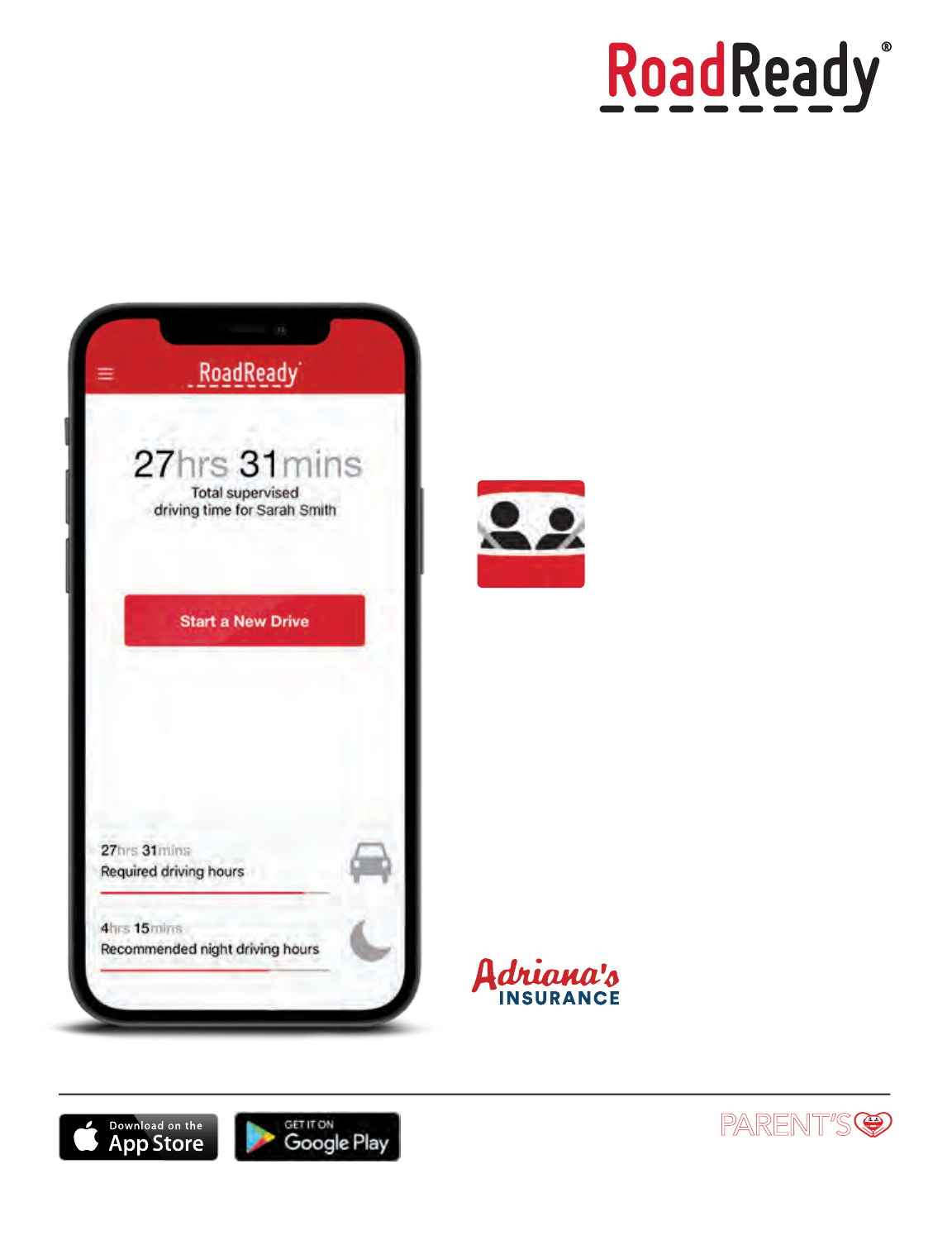
LOG YOUR DRIVES.
FOCUS ON YOUR TEEN.
Teaching your teen to drive presents
enough challenges. With RoadReady,
your focus can remain where it needs
to be: on your teen and on the road.
“Start a New Drive” and RoadReady
will log the rest. Download your log
to verify you’ve completed your
state requirement.
WITH SUPPORT FROM
Apple, the Apple logo and iPhone are trademarks of Apple Inc., registered in the U.S. and other countries. App Store is a service mark of Apple Inc.
Google Play and the Google Play logo are trademarks of Google LLC.
LEARN MORE AT ROADREADYAPP.COM
A component of the
PARENT’S
Supervised Driving Program
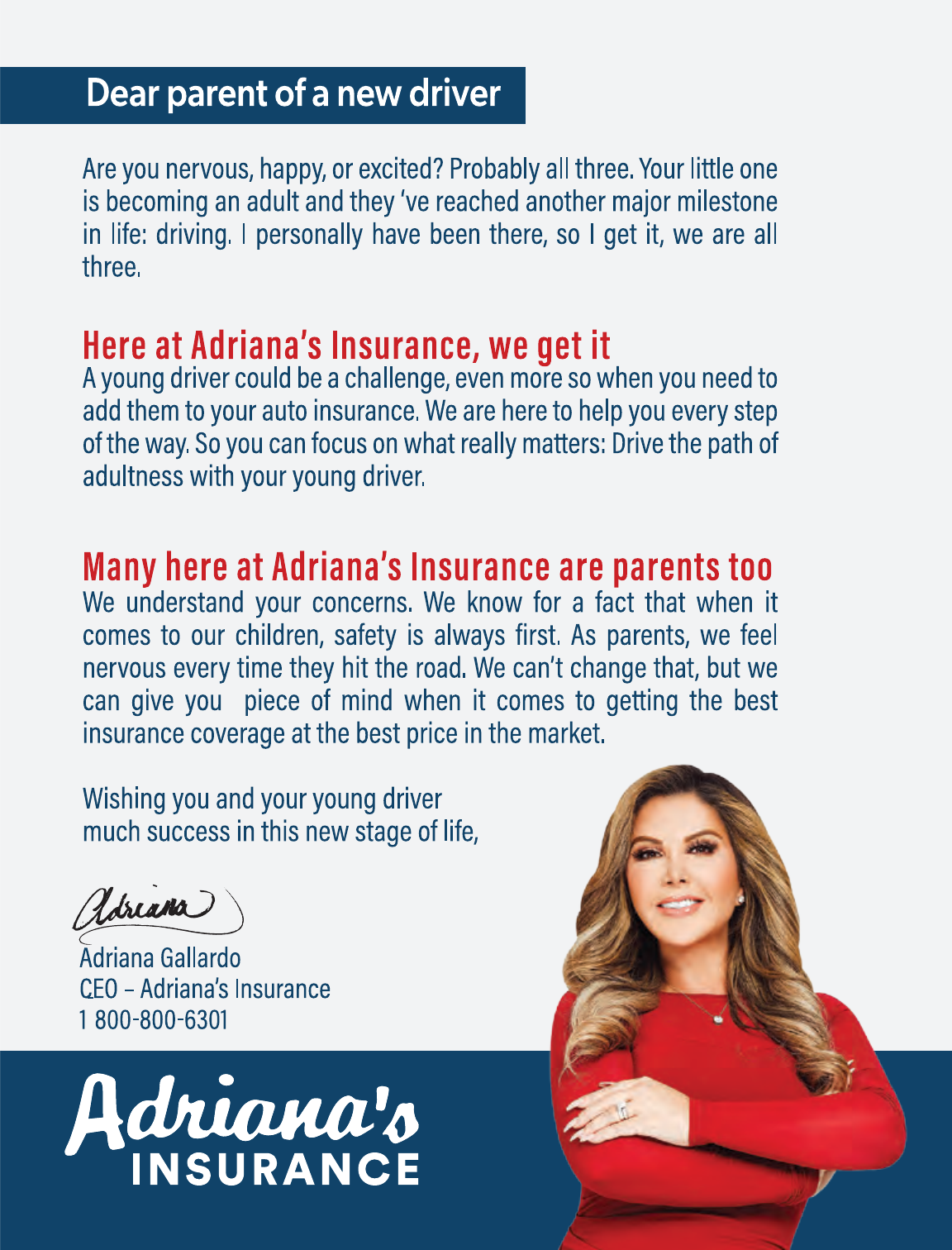
LOG YOUR DRIVES.
FOCUS ON YOUR TEEN.
Teaching your teen to drive presents
enough challenges. With RoadReady,
your focus can remain where it needs
to be: on your teen and on the road.
“Start a New Drive” and RoadReady
will log the rest. Download your log
to verify you’ve completed your
state requirement.
WITH SUPPORT FROM
Apple, the Apple logo and iPhone are trademarks of Apple Inc., registered in the U.S. and other countries. App Store is a service mark of Apple Inc.
Google Play and the Google Play logo are trademarks of Google LLC.
LEARN MORE AT ROADREADYAPP.COM
A component of the
PARENT’S
Supervised Driving Program

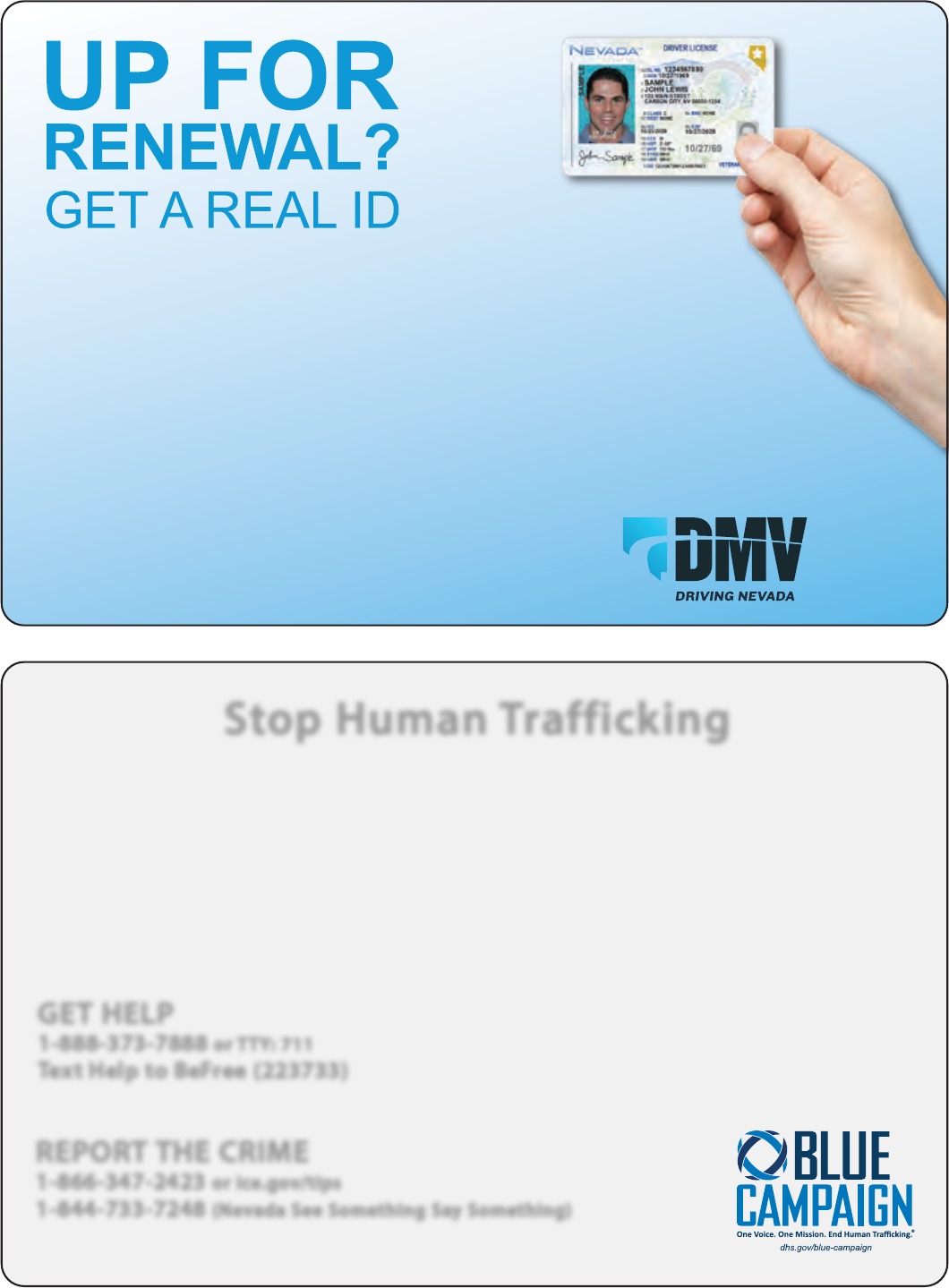
Parents, your teen’s instruction permit is probably already a Real ID.
But what about yours?
A Real ID will be required beginning May 3, 2023, if you wish to use your
driver’s license or state ID to board commercial aircraft on domestic ights.
Secure federal facilities such as military bases already require licenses to be Real
ID compliant.
Upgrade during your next renewal or other change to your license, or even the same day
your teen takes the skills test.
Get the facts at dmv.nv.gov/realid.
Stop Human Trafficking
The National Human Tracking Hotline provides condential help and support in more than 200 languages.
GET HELP
1-888-373-7888 or TTY: 711
Text Help to BeFree (223733)
REPORT THE CRIME
1-866-347-2423 or ice.gov/tips
1-844-733-7248 (Nevada See Something Say Something)
Human tracking is modern-day slavery and involves the use of force, fraud, or coercion to obtain some type of
labor or commercial sex act. Tracking victims can be men or women, young or old, American or from abroad,
with or without legal status. Nevada ranks among the ten worst states for these heinous crimes.
Don’t be a victim! Here’s what to watch for:
• Strangers requesting to talk to you, saying they think they know you
• Asking a lot of personal questions or seeming overly interested, particularly if you are sad or emotional
• Oering gifts or opportunities that seem too good to be true, including modeling or acting jobs
• Requests for photos, private conversations or meeting up in person
• Telling stories that don’t make sense or no matter what you say, they agree with you to gain your trust
Never approach a tracker yourself. Call 9-1-1 in an emergency.

-
’
’
-
’
PARENT’S
About this program
Developed by Safe Roads Alliance, a
non prot dedicated to promoting safer
driving through education for drivers of
all ages, The Parent s Supervised Driving
Program is designed to improve teen
driver safety by providing parents and
guardians with a methodical approach
to teaching the requisite driving skills.
Each lesson concentrates on a particular
sequential skill. Parents are in the best
position to help their teens become safe,
smart, and skilled drivers.
The Parent s Supervised Driving Program
also includes a website, social media
pages, and a mobile app, RoadReady
®
.
Publisher: Safe Roads Alliance -
info@saferoadsalliance.org
Illustrator: Lou Eisenman
Thanks to the following for help in
developing this program: Jeff Larason,
Travelers Marketing, In Control Family
Foundation, Colleen Kelley, and Lisa
Kennedy Cox.
Special thanks to Kevin Malone, April
L. Sanborn and Jennifer Pitts at the
Nevada DMV.
Published in association with the Nevada
Department of Motor Vehicles.
With support from:
• Adriana s Insurance
Copyright © 2022 J.F. Grifn Publishing
and Safe Roads Alliance. All rights reserved.
Printed in the United States of America.
Produced by J.F. Grifn Publishing.
The
PARENT’S
Supervised Driving Program
Welcome parents
of teen drivers!
The Parent’s Supervised Driving Program is a resource for
parents to utilize when teaching their teen to drive.
1. This program is divided into 13 core driving skills.
• Read through each section at home before
your teen starts a new skill.
2. Log your driving time. This can be done 2 ways:
• Carry this printed guide with you during the
drive and use the printed log section – you or
your teen can log the supervised driving hours
once the drive is nished.
• Download and use the free
app
to track your driving time. RoadReady tracks
your teen’s driving hours until you reach the
state requirements.
This program is also
available online at:
PSDPonline.com
3. Turn in your log when applying for your license.
Stay Connected
with Us!
Follow The Parent’s Supervised
Driving Program for expert
driving articles, program launch
events and additional safety
resources.
Facebook
www.facebook.com/
TheParentsSupervisedDrivingProgram
Twitter
www.twitter.com/PSDP_Info
Instagram
www.instagram.com/roadreadyapp

A PROGRAM OF THE NEVADA DEPARTMENT OF MOTOR VEHICLES
Table of contents
Notes for parents/guardians
About supervising teen drivers .....................................................................................1
Vehicle control for supervisors
......................................................................................2
Distracted driving and more
........................................................................................3
Focus on the road ahead
............................................................................................4
Skills
Skill one: before you start the engine ..............................................................................6
Skill two: moving, steering, and stopping
.........................................................................7
Skill three: how close are you?
......................................................................................8
Skill four: backing up
.................................................................................................9
Skill ve: driving on a quiet street – part one
................................................................... 10
Skill ve: driving on a quiet street – part two
.................................................................... 11
Skill six: looking ahead
............................................................................................. 12
Skill seven: turning around
........................................................................................ 13
Skill eight: parking – part one
..................................................................................... 14
Skill eight: parking – part two
..................................................................................... 15
Nevada teen driver laws
........................................................................................... 16
Supervised driving log
............................................................................................. 17
Skill nine: driving on rural roads
................................................................................... 24
Skill ten: multi-lane roads – part one
.............................................................................25
Skill ten: multi-lane roads – part two
.............................................................................26
Skill eleven: city driving – part one
...............................................................................27
Skill eleven: city driving – part two
...............................................................................28
Skill twelve: highway driving – part one
.......................................................................... 29
Skill twelve: highway driving – part two
..........................................................................30
Skill thirteen: roundabouts
........................................................................................ 31
Beyond the basics
Adapting to new landscapes ......................................................................................32
Continuing education
..............................................................................................33
Practice in other conditions
.......................................................................................34
Teens’ biggest dangers
............................................................................................35
Sharing the road with trucks
.......................................................................................36
Sharing the road with bicyclists and pedestrians
............................................................... 37
Your opinion
matters
Take our program
survey and tell us about
your experience.
www.theparentssupervi
seddrivingprogram.com/
survey.html
WITH SUPPORT FROM

NOTES FOR PARENTS/GUARDIANS
Check your
emotions
At the start of each
driving lesson with your
teen, leave your problems
behind — and make an
effort to stay focused.
Bringing up touchy
subjects such as grades,
homework, relationships,
etc. can distract either of
you from the task at hand.
About supervising teen drivers
The Parent’s Supervised Driving Program gives you a simple, easy-to-follow plan you can use to help
your teen be a safe and responsible driver.
Some thoughts as you begin this exciting experience together:
Make an effort to enjoy the learning process: Driving is a big step toward independence, and your
teen is entering a new phase of life. You’ll both remember this experience for years to come. Make it a
good memory!
Practice, practice, practice: Studies show that the risk of a crash diminishes with experience. The
more time you can spend driving with your teen, the less likely it is they’ll crash when they begin driving
alone. Driving in a variety of circumstances is equally important. While using this program, you should
drive on all types of roads. Make sure your teen gets exposure to a variety of roadways, and in different
conditions as well: at night; in rain, fog, and snow; and in heavy and light trafc.
Be a driving role model: It’s not enough to say, “Do as I say.” Children imitate their parents’/guardians’
behavior, so your driving should set a good example for your teen to emulate. Be sure that you:
• Obey all trafc laws.
• Correct any unsafe driving habits (driving aggressively, rolling through stop signs, accelerating through
yellow lights, speeding, etc.).
• Refrain from using your cell phone at all while driving.
• Always wear your seat belt, and remind your teen that buckling up is the law. This will need to be an
ongoing conversation - buckle up every trip, every time.
Tips for teaching your teen
• Seat belts must always be worn properly by everyone in the vehicle.
• Before each session, discuss the goals of the day’s lesson.
• Before each new lesson, review what was learned during the previous lesson.
• Keep instructions simple and concise. Say where to go and what action to take. For example: “Drive
to the corner and turn right.” Give the direction with enough time for your teen to process and safely
execute the maneuver.
• The feedback you give should be calm, precise, and immediate. Be patient and alert at all times.
Remember to give positive feedback when your teen succeeds!
• When your teen makes a mistake, which will happen often, do not criticize. Remain calm and simply
repeat the maneuver until it’s done correctly. To minimize their frustration, emphasize to your teen that
mistakes are a normal part of learning.
• These lessons should be consistent with what is taught by your teen’s driving instructor. If you teach
something differently, your teen will be confused and learning will be more difcult. If the lessons in
this program are different from the instructor’s, contact them to clarify the discrepancy.
• Remember that students learn at different paces. Make sure your teen has mastered each skill
before you move on to the next lesson, even if that means repeating a lesson several times. Patience
and practice will pay off in the long run.
• Integrate night driving into as many lessons as possible.
Most importantly, make sure the vehicle you use for training is safe. Conrm that the brakes have
been recently inspected, and check to make sure the tires have sufcient tread depth. It’s generally
recommended that you do not train in larger vehicles that lack stability control.
1

NOTES FOR PARENTS/GUARDIANS
Vehicle control for supervisors
Teaching a new driver can be stressful, but knowing you have some control can help. Professional driver
education instructors are taught emergency responses to potential hazards that can crop up with an
inexperienced driver behind the wheel. Here are some skills you can learn to help you maintain control
from the passenger seat while teaching:
Emergency shifting: In a quiet, large, level, empty area, practice shifting the transmission
from drive to neutral. This would be necessary if the accelerator becomes stuck.
Taking the wheel: With an experienced driver in the driver’s seat, in a quiet, large, level,
empty area, practice steering the car with your left hand from the passenger seat.
Mirrors: Adjust the mirror on the passenger sun visor so you can use it as a rearview
mirror. If the right side mirror is properly adjusted, you can use it to monitor trafc to the
rear from the passenger seat.
Awareness: Never assume everything is okay. Always check and re-check mirrors before
you give instructions to your teen. Remember that you are a second set of eyes and ears,
and you need to be alert and ready to help your teen.
Commentary
driving
Commentary driving is
a great communication
tool. Coach your
teen to describe their
actions, thoughts and
observations out loud
as they drive, similar to
a sports commentator.
Throughout the learning
process, ask them to
verbalize what they see
around them, including
potential risks and any
steps they need to take
to avoid those risks.
Encourage your teen to
verbalize an action they
plan to make, such as
turning, merging and
approaching trafc lights.
Emergency stopping: Practice stopping the car with the parking brake (if your vehicle’s
parking brake is located between the seats). This can be dangerous, even at low speeds,
and should only be used as a last resort.
Driving has changed
Chances are, today’s cars are not the same as they were when you learned to drive. To teach your teen
effectively, you need to know about a few important recent changes in how cars work, how we drive,
and how driving is taught.
Anti-lock Brake System (ABS): Most newer cars offer ABS as standard equipment. ABS is a dramatic
safety improvement that works by letting the tires rotate, rather than lock up, when the brake is engaged.
This allows drivers to steer the car in an emergency stop. ABS should be used with rm, continuous
pressure. The brakes may shake and grind when applied, which often concerns users – but this is a normal
function of ABS. To nd out if your car has ABS, check the instrument panel after you turn on the ignition
or read the owner’s manual.
Note: When driving a car without ABS, the old rules still apply. Don’t “slam” the brakes. Rather, press the
brake pedal rmly. The intention is to stop quickly, but also to avoid locking the brakes and skidding.
Skidding causes a loss of control.
Air bags: Air bags are designed to work with seat belts, which must be
worn for the air bags to be effective. The use of a seat belt allows the
driver to stay behind the wheel in order to take advantage of the airbag.
Since air bags deploy out of the wheel on impact, it’s important to keep
your hands and arms in the recommended position.
Steering wheel hand position: Most of us were taught to position our
hands at 10 and 2 o’clock on the steering wheel. It’s now suggested that
you hold the wheel at 9 and 3 o’clock. This gives you better vehicle control
and also lessens the risk of injury if the airbag was to deploy.
Nevada law does not specify either position but you must keep both
hands on the wheel.
Arms holding the wheel at 9
and 3 o’clock are not as likely
to be hit by the air bag.
2

NOTES FOR PARENTS/GUARDIANS
Eyes on the road
Teens tend to look
away from the road and
become distracted for
longer periods than older
drivers. It’s important to
train them to keep their
eyes on the road ahead.
While parked, test your
teen on how long they
look away when doing
various tasks inside the
vehicle, such as adjusting
the temperature. Coach
them repeatedly on the
importance of focusing
on the road ahead.
Distracted driving and more
Distracted driving involves any activity that takes the driver’s attention away from the primary task
of driving. Distracted driving, impairment, speeding, and not wearing seat belts are all risky choices
that can lead to serious injury and death. Teens, who are still learning the complex skills of driving,
are particularly susceptible to distractions while behind the wheel. Don’t let you or your teen become
another statistic. Here are the facts:
• Motor vehicle crashes are the leading cause of death for U.S. teens. Mile for mile, teens ages 16-19
are involved in 3 times as many fatal crashes as all other drivers. And 1 in 3 teens who text say they
have done so while driving.
• According to NHTSA, 3,142 people were killed in 2020 in distraction-related crashes nationwide,
with teens having the highest rate of distracted driving crashes involving a fatality.
• A Virginia Tech Transportation Institute study revealed that physically dialing a phone while driving
increases the risk of a crash as much as 6 times. Texting is riskier still, increasing collision risk by 23 times.
There are three kinds of distractions:
• Visual – doing something that requires the driver to look away from the driving task.
• Manual – doing something that requires the driver to take one or both hands off the wheel.
• Cognitive – doing something that causes the driver’s mind to wander or focus elsewhere.
To combat this growing epidemic, we suggest the following:
• Set a good example: Kids observe and learn from their parents. Put your phone away while driving
and only use it when you are safely pulled over. According to the Pew Research Center, 40 percent of
teens aged 12 to 17 say they have been in a car when the driver used a cell phone in a way that put
themselves and others in danger.
• Follow the law: Hand-held cell phone use, texting, messaging or accessing the internet while driving
are illegal activities in Nevada.
• Talk to your teen: Discuss the risks and responsibilities of driving and the danger of dividing their
attention between a phone call and the road. Show them the statistics related to distracted driving
and urge them to share what they learn with their friends. Encourage them to speak up if they are a
passenger in a car with a distracted driver.
• Establish ground rules: Set up family rules about not using the phone or other electronic devices
while behind the wheel. Enforce the limits set by the graduated licensing program.
• Sign a pledge: Have your teen take action by agreeing to a family contract about wearing seat belts,
not speeding, not driving after drinking, and not using a cell phone behind the wheel. Agree on
penalties for violating the pledge, including paying for tickets or loss of driving privileges.
• Other dangerous distractions: In addition to cell phone use, distracted driving can include eating,
grooming, drinking, listening to or adjusting the radio or MP3 player, using the GPS, talking to
passengers, or watching a video, just to name a few activities. Inexperienced drivers are particularly
susceptible to these kinds of distractions.
Drugged driving
• As more and more states legalize marijuana, it’s important to remember that it’s illegal for everyone
under 21. And just because it’s legal doesn’t mean it’s safe. Laws for operating under the inuence
of alcohol also apply to drugs. Almost any drug can affect your driving skills, including illegal drugs,
prescription medicine, and even over-the-counter medicine. Smoking or ingesting marijuana makes it
more difcult to respond to sights and sounds. This makes you dangerous as a driver; it lowers your
ability to handle a quick series of tasks. The most serious problems occur when facing an unexpected
event, such as a car coming out from a side street or a child running out between parked cars. These
challenges get worse after dark, because marijuana can also limit night vision.
3

NOTES FOR PARENTS/GUARDIANS
Focus on the Road Ahead
As a teenager, getting your driver’s license is a huge milestone. Along with the freedom that comes
with being a licensed driver comes responsibility and risk. Over 23% of drivers have uncorrected vision
problems, which impacts the safety of drivers, pedestrians, and other road users. When it comes to teenage
driving, safety and sight go hand in hand. Ensuring proper vision is a smart and practical way to reduce the
risk of young drivers getting into a motor vehicle crash. Here are some tips to keep focused while driving.
Eyes on the Road
Prioritize annual eye exams—vision changes occur throughout life.
Always wear your glasses while driving—even if you have a mild prescription.
Avoid driving while tired or sick—these symptoms can impair visual function.
Remove obstructions to peripheral vision—it’s critical for motion detection.
Day Driving
Whether driving to work or school, it’s important to avoid visual distractions while driving during
the day. Over time, glasses can develop scratches which impact optical quality. Regularly clean and
inspect lenses and replace glasses when necessary. Also, you should refrain from placing items on the
dashboard to avoid reections on the windshield.
Sunglasses are an effective way to protect eyes from sun damage and glare while
on the road. For those who need prescription eyewear, be sure to invest in a pair of
prescription sunglasses to avoid swapping out glasses for non-prescription sunglasses
while driving on a bright day. Remember, one condition does not cancel out the other!
See the Signs
Did you know that US
road signs are specically
designed based on sight-
distances of drivers with
20/30 vision? People with
20/40 vision or worse may
struggle reading road
signs and executing safe
driving decisions.
Polarized sunglasses lter out more glare than regular sunglasses and are a great way to protect the
eyes from harsh sunlight. They also boost contrast and can assist with improving reaction times when
driving in bright or wet road conditions.
Night Driving
Practicing driving at night is vital for safety. Logging an equal amount of day and night practice
hours helps to identify the specic hazards encountered in different natural light levels.
Some facts to consider:
• The road crash fatality rate at night is 2-4x higher than day driving.
• In 2020, 44% of teen driving fatalities occurred between 9 pm and 6 am.
• Teen drivers are 3x more likely to be involved in fatal nighttime crashes vs adults.
Seeing clearly is vital for teens driving at night. Studies have found that even minor uncorrected vision is
amplied in night driving conditions. Low light and headlight glare make it difcult to spot hazards for
those without properly corrected vision.
Anti-Reective (AR) coating is an excellent lens option for night driving. Not only does it allow more light
in, it also cuts down glare and can improve night vision.
QUALITY PRESCRIPTION GLASSES STARTING AT $6.95.
4
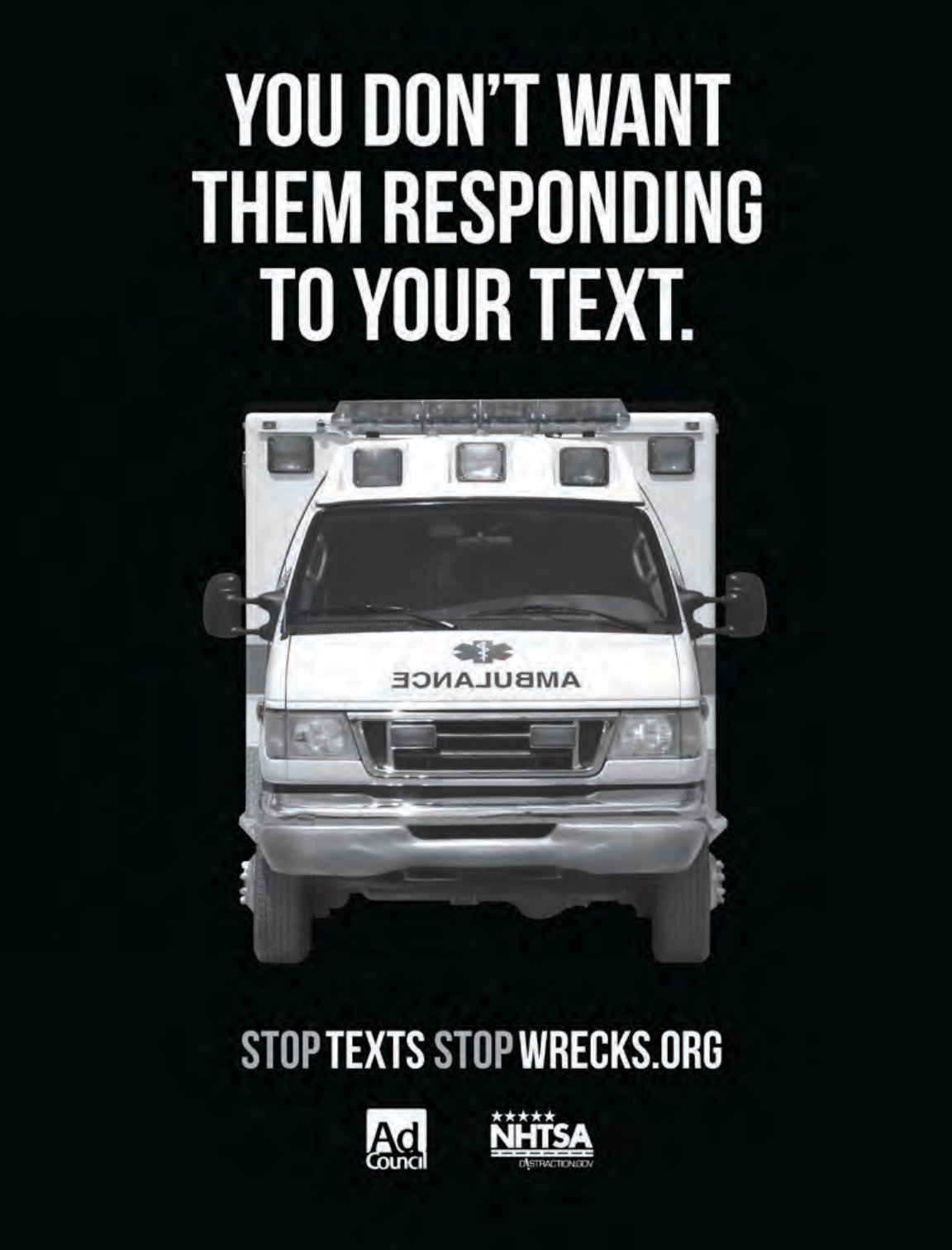
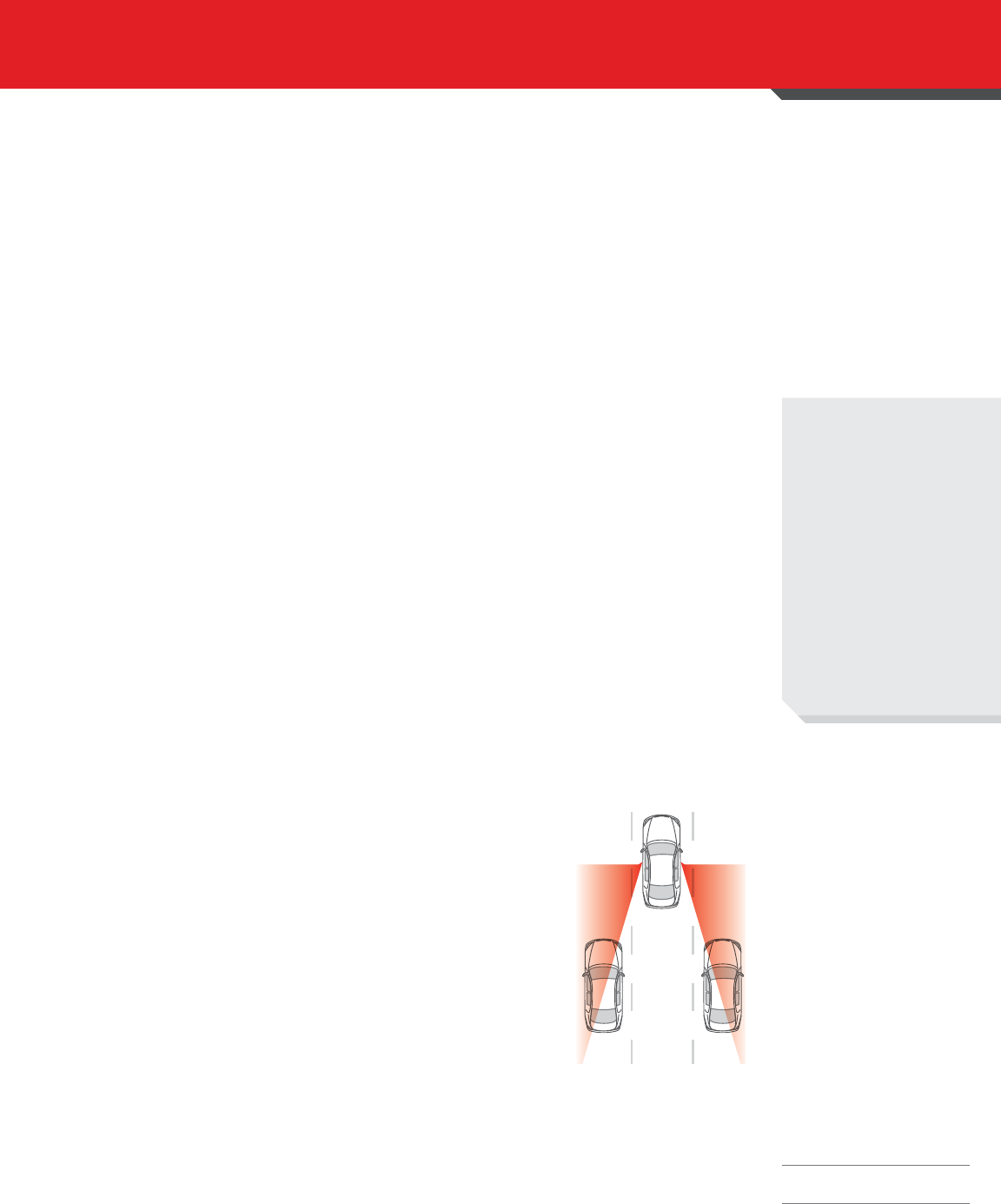
SKILL ONE
:
BEFORE YOU START THE ENGINE
Before you start the engine
Goal: Teach your teen vehicle basics before actual driving begins.
Location: Parked. This is a non-driving lesson.
Lesson one – touring the vehicle
Walk around the outside of the car with your teen. Instruct them to look for leaks and hazards such as
broken glass, and to make sure it’s clear behind the vehicle as well as in front of the vehicle.
Have your teen practice these basic skills until they don’t need help:
• Starting and stopping the engine
• Naming and operating all dashboard controls
• Checking oil level
• Checking wiper uid
• Checking tire pressure
• Checking tire tread depth
Lesson two – mirror settings
The method below provides the best view of adjacent lanes, for maximum safety:
• Inside mirror: Have your teen sit up straight in the driver’s seat and adjust the inside mirror
so that it frames the entire rear window. This is the main mirror for viewing what is behind the vehicle.
• Left-side mirror: Have your teen lean their head toward the left-side window, and set the left mirror so
they can barely see the side of the car. When they sit up straight, the car should no longer be visible in
the mirror.
• Right-side mirror: Do the same to the right. Have your teen lean to the right over the car’s center
console, and set the right mirror so they can barely see the right side of the car.
Lesson three – checking blind spots
Additionally, teach your teen how to look over their shoulder to check the
blind spot on each side of the car that cannot be seen in the mirrors. Blind
spots should be checked every time you change lanes.
Lesson four – seating position
The proper seat position is important to safely control the vehicle. Your
teen should sit with their back rmly against the seat. There should be at
least 10 inches between the steering wheel and the driver’s chest, with the
air bag pointing at the chest. The top of the steering wheel should be no
higher than the shoulders. Move the seat forward or backward so that the
driver’s heel touches the oor and can pivot quickly between the brake and
accelerator. Shorter drivers may need a seat cushion or pedal extenders
to sit safely 10 inches from the air bag. The head restraint should be at the
The most effective way to
deal with blind spots is to
center of the driver’s head.
briey turn and look.
Lesson ve – proper footwear
Wearing the right shoes has an effect on operating a vehicle. Flip ops are dangerous to wear while
driving, so encourage your teen to wear shoes that have a at sole and a back. Driving barefoot is unsafe
as well. Keep an extra pair of shoes in the car so your teen can remember to wear the proper shoes while
driving. If they need to brake suddenly, the wrong footwear can make for an unsafe situation.
Proper mirror
setting
In the past, drivers were
often taught mirror
settings that created an
overlap between the rear
and side mirrors. This is
actually less safe because
it increases the size of the
blind spots. This is a great
opportunity to update
your own driving skills
while teaching your teen!
Skill completed
supervisor initials
driver initials
#RoadReady
6

SKILL TWO
:
MOVING, STEERING, AND STOPPING
Controlling speed
New drivers tend to use
the brake too much and
the accelerator too little
to control speed. Coach
your teen about easing
up on the accelerator
as a way to reduce the
car’s speed.
Moving, steering, and stopping
Goal: Teach your teen to consistently start, stop, and turn smoothly with full vehicle control.
Location: A large, level, mostly empty area.
Everyone in the vehicle must be properly buckled up.
Before starting, coach your teen to always signal and check mirrors and blind spots before changing the
speed, position, or direction of the car. Remind them when needed.
Have your teen drive around the perimeter of the lot several times at a slow speed. Have them stop and
start frequently, practicing smooth hand-to-hand steering, braking, and accelerating.
Pick several targets in the large, level, empty practice area, and have your teen drive to them at specic
speeds. For example, “Drive to the stop sign at 15 mph.” Focus on steady speed and smooth starts
and stops.
Once your teen is braking smoothly, practice “hard, smooth stops” at slightly higher speeds
(approximately 25–30 mph). Hint: Curling toes back just before braking results in smoother stops. It
eases the pressure on the brake.
Lesson one – steps toward turning
Turning right Turning left
Step 1
Left hand Right hand Left hand Right hand
slides down pulls down pulls down slides down
Left hand Right hand Left hand
Right hand
pushes up slides up slides up pushes up
Step 2
Step 3
Left hand Right hand Left hand Right hand
slides down pulls down pulls down slides down
With hand-to-hand steering, your hands do not cross each other.
Lesson two – turning techniques
• Ease off the accelerator or use the brake to reduce speed before entering a curve; use gentle
acceleration to overcome inertia and pull the vehicle out of the curve.
• Use smooth, continuous steering wheel movements when approaching a turn and when returning
(sliding) the wheel through the hands until the vehicle is in the proper post-turn position.
Skill completed
• Coach your teen to pick a target near the center of the intended travel path. This target can be
used as a visual aid to aim at while steering through turns.
supervisor initials
driver initials
#RoadReady
7
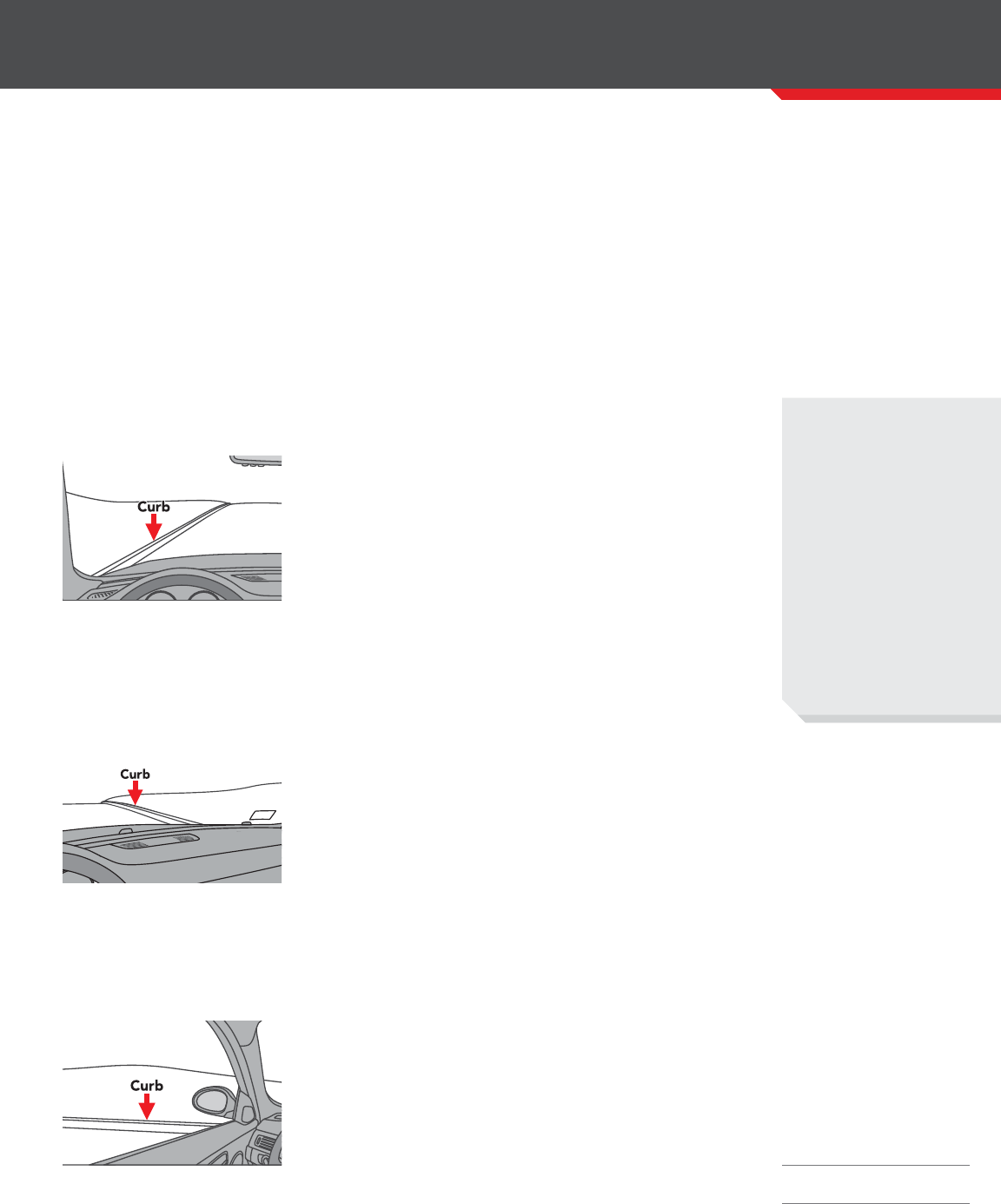
SKILL THREE
:
HOW CLOSE ARE YOU?
How close are you?
Goal: Teach your teen how to tell where their vehicle is in relation to other vehicles or objects.
Location: A large, level, mostly empty area with clearly painted pavement lines and curbs.
Reference points
Explain to your teen that reference points are visual guides to help them judge the car’s distance from
curbs, lines, other objects, and vehicles.
Lesson one – driver’s side curb (or line)
• Choose a pavement curb (or line), and tell your teen that the goal
is to pull the driver’s side of the vehicle within 18 inches away.
Coach them to slowly pull up parallel to the line, getting gradually
closer, and stop when they think they are within 18 inches away.
Have them look at where the line intersects in the front window.
• Have your teen put the car in park and get out to check if the
driver’s side wheels are within 18 inches from the line. If it’s
not the right distance, have them do it again, checking the
View out the front windshield.
reference points.
Reference points will be different
for everyone, depending on the
vehicle and the height of the driver.
Lesson two – passenger’s side curb (or line)
• Choose another curb (or line) parallel to the passenger’s side,
again pulling up slowly to within 18 inches. Use the same gradual
pull-up method, but for this side, coach your teen to stop when
the curb appears to intersect the center of the hood.
• Again, have your teen get out of the vehicle to check whether
the tires are within 18 inches from the curb. Keep practicing and
making adjustments, noticing the reference point, until they can
do it consistently.
View out the front windshield.
Reference points will be different
for everyone, depending on the
vehicle and the height of the driver.
Lesson three – front curb (or line)
• Teach your teen to align the front bumper between within 18
inches from a pavement curb (or line). Have them drive slowly
straight toward the curb. Coach them to stop when the curb
appears under the driver side mirror.
• Have your teen get out of the vehicle to check whether the
front bumper is within 18 inches from the curb. If not, have
them adjust the reference point as needed and keep practicing.
View out the driver’s side window.
Reference points will be different
for everyone, depending on the
vehicle and the height of the driver.
Making your
teen safer
It takes more than
15 minutes every day for
six months to complete
50 hours of practice
driving. For 100 hours, it’s
more than 30 minutes a
day for six months. Studies
show that the more time
you drive together, the
safer your teen will be
when driving alone.
Skill completed
supervisor initials
driver initials
#RoadReady
8

SKILL FOUR
:
BACKING UP
Slow and consistent
Emphasize that it is
important to back up
slowly and be prepared
to stop. It is harder to
maintain control of the
car when it’s in reverse.
Skill completed
supervisor initials
driver initials
#RoadReady
Backing up
Goal: Teach your teen how to safely drive backwards in a straight line and while turning.
Location: A large, level, mostly empty area.
Lesson one – before moving the vehicle
• Coach your teen to rst search around the vehicle before entering to identify potential hazards that
may not be visible once they are in their seat. Then teach your teen that they must always turn around
and look backwards through the rear window when backing up. They should also use their mirrors and
back-up camera.
• Have your teen shift their hips and turn around until they get a good view behind the vehicle. When
backing up to the right, they should drape their right arm over the back of the seat and grasp the top
of the steering wheel with their left hand. When backing up to the left they should look over their
left shoulder.
• Review how to use the backup camera with your teen, including what the different lines mean. Always
remember that a camera cannot be a substitute for your eyes - it is meant as an additional tool to use
when backing up.
Lesson two – backing up in a straight line
• Check all areas behind the vehicle prior to and while backing up.
• Grasp the steering wheel with the left hand and look over the right shoulder through the rear window.
• First release the brake, then use the accelerator gently, and only when necessary, to control speed.
Keep it slow.
Lesson three – backing up in a turn
• If turning to the left, grasp the steering wheel with the right hand, or with the left hand if turning to the
right. Remind your teen to turn the wheel in the direction they want the car to travel.
• Look in the direction the car is moving through the rear side windows.
• Back into the turn slowly, rst releasing the brake, then using the accelerator if needed.
Lesson four – aligning rear bumper to a curb
• Choose a curb (or line) for a target.
• Have your teen back up toward the target,
coaching them to stop when the curb appears
near the middle of the rear right window when
looking over their right shoulder.
• Have your teen put the car in park and set the
emergency brake.
• Have your teen get out of the car to see
whether the rear bumper is close to the target.
• If adjustments are needed, have your teen
try again, establishing a new reference point.
Repeat as often as needed until your teen can
consistently come within close proximity to
the target.
The driver’s view out of the back passenger window.
Reference points will be different for everyone,
depending on the vehicle and the height of the driver.
9

SKILL FIVE
:
DRIVING ON A QUIET STREET – PART ONE
Driving on a quiet street – part one
Goal: Teach your teen to move and stop a vehicle safely and with condence on quiet roads.
Location: Start in a large, level, mostly empty area. Move to a quiet neighborhood street when
indicated. Out of respect to our neighbors, please do not use ofcial state road test courses for practice.
Before moving out onto the road, make sure that your teen has reviewed the driver’s manual and is
familiar with street signs, signals, pavement markings, and right-of-way and speed laws.
Skill review
Starting in a quiet, large, level, empty area, review the skills learned so far. Have your teen drive several
laps around the lot, practicing smooth braking and accelerating, maintaining steady speeds, steering
into right and left turns, and using reference points to align the car with curbs (or lines).
Lesson one – commentary driving
Coach your teen to use “commentary driving” (see sidebar on page 2) throughout this lesson, if possible.
Lesson two – lane position
When you and your teen feel ready, move to a quiet street.
With your teen behind the wheel, rst have them practice driving straight in three different lane
positions. Do this for several miles, practicing each position at least 10 times:
Center position
➊
: The most common position, with the vehicle centered within the lane. Coach your
teen that they should stay in the center
position under most circumstances.
➌
Left position
➋
: The vehicle positioned
to the left side of the lane. This is best
used when approaching parked vehicles
and potential hazards on the right (if no
➊
oncoming trafc). It should be avoided on
a hill or a curve.
Right position
➌
: The vehicle positioned
to the right side of the lane. This is usually
➋
done when making a right turn to allow
for a safety margin on the left side of
Most driving is done in lane position number one.
the vehicle.
Lesson three – intersections
Coach your teen on these techniques for safely approaching an intersection:
• Search for vehicles, pedestrians, signs, and trafc signals.
• Check the rearview mirror for any potential hazards behind the car.
• If it’s an intersection with trafc signals, identify who has the right-of-way.
• If turning, put on your turn signal at least 100 feet ahead (about 10 car lengths) on city streets and 300
feet (30 car lengths) on open highways.
• If a stop is required, stop behind the white stop line or crosswalk, whichever comes rst.
• Select the best lane for travel by reading signs and pavement markings.
• Yield the right-of-way to pedestrians and other vehicles.
Emergency vehicles
Make sure your teen
understands what to
do if they encounter
emergency vehicles. First,
turn down the radio to
listen for the direction of
the emergency vehicle(s).
Stay calm and pull over to
the nearest curb, clear of
intersections, and wait for
the emergency vehicle(s)
to pass.
Move Over Law
When you approach a
stopped emergency
vehicle or any other trafc
incident on the roadway,
you must:
Decrease your speed
to less than the posted
limit and, if possible,
drive in a lane that is
not adjacent to the lane
in which the incident
has occurred.
Skill completed
supervisor initials
driver initials
#RoadReady
10
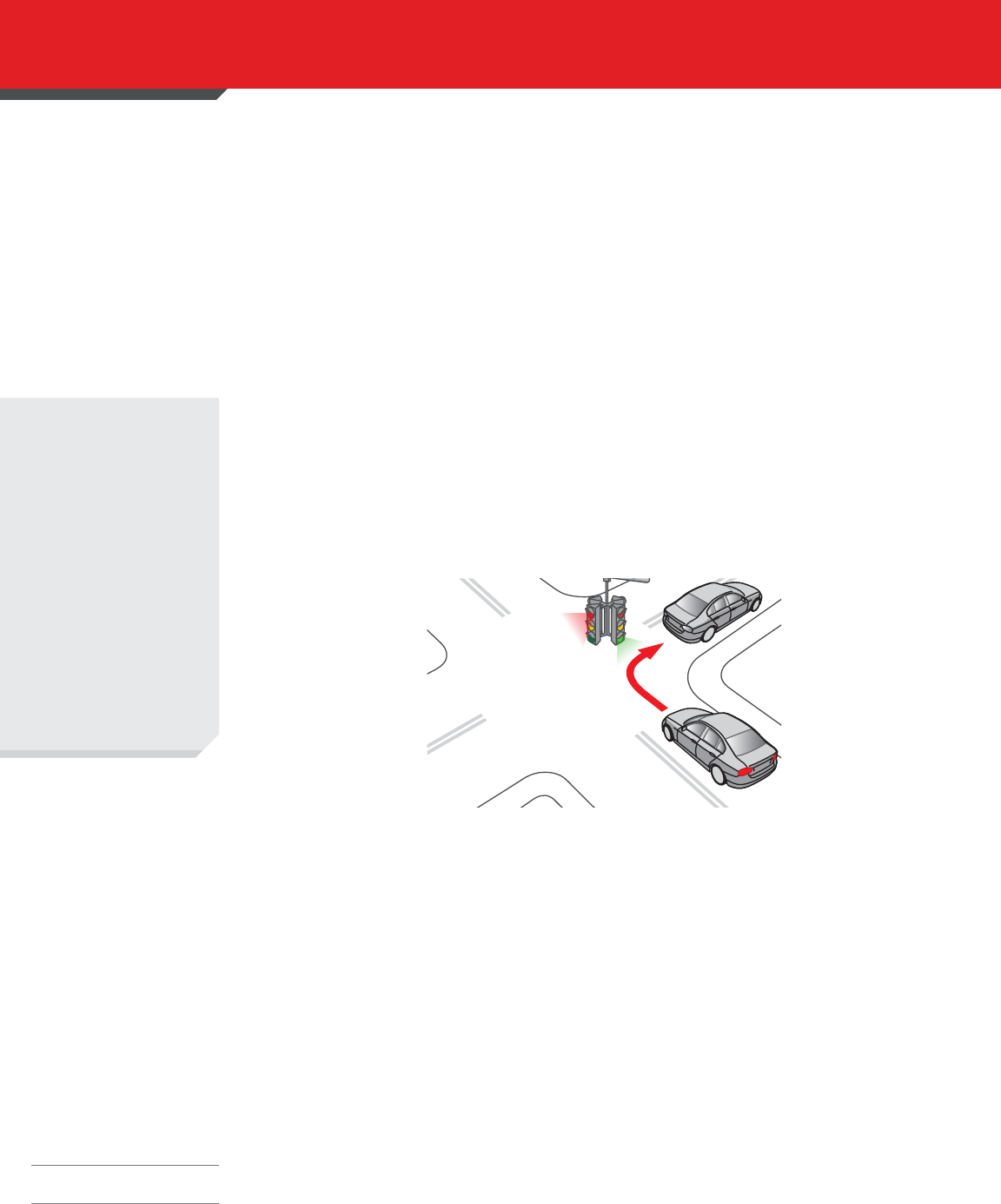
SKILL FIVE
:
DRIVING ON A QUIET STREET – PART TWO
Focus ahead
Most drivers have a
tendency to steer in the
direction they look. If
their eyes move to one
side, the car may drift
in that direction, too.
Remind your teen to
focus on a path line in
the middle of their travel
lane — and not xate
on lane lines or other
objects. The rest of the
area should be scanned
quickly and frequently.
Skill completed
supervisor initials
driver initials
#RoadReady
Driving on a quiet street – part two
Goal: Teach your teen to turn both right and left safely and with condence on quiet roads.
Location: A quiet block of single-lane roads, ideally without trafc signals at the intersections.
Lesson one – right turns
When your teen is comfortable with lane positions and intersections, it’s time to practice turns.
Start with right turns. Have your teen drive clockwise around the block 10–12 times:
• Pick a line at the center of the intended travel path while steering through a turn. Make sure
your teen does not xate on one specic spot, but instead focuses on a broader path.
• Focus on smooth braking into the turn and acceleration out of the turn, as previously practiced
in the large, level, empty area.
• Always check mirrors before turns and signal at least 100 feet ahead on city streets or 300 feet ahead
on open highways. Make sure to check for vulnerable users, such as bicyclists and pedestrians,
before turning.
Have your teen drive around the block making right turns
10–12 times. When they are procient, drive around the
block 10–12 times making left turns.
Lesson two – left turns
When your teen is procient at right turns, move on to left turns. Have your teen drive counterclockwise
around the block 10–12 times, coaching them on these techniques for safe left turns:
• Position the vehicle close to the yellow line in the middle of the road.
• If there is a stop sign or red light, stop with wheels pointed straight and make sure to stop before the
stop line, crosswalk, or sidewalk, whichever is rst.
• Search the intersection in all directions for vehicles, pedestrians, signs, and signals.
• Select a gap in trafc and pull straight forward toward the middle of the intersection.
Coach your teen to avoid hesitating.
• Use the yellow line on the street being turned onto as a target. Turn into the travel lane
closest to the yellow line.
• When the turn is complete, let the steering wheel slide back through the hands.
• Pick a new target 15–20 seconds ahead in the center of the travel path and accelerate gradually.
Be sure to practice with your teen in a variety of conditions, including at night and in
inclement weather, as much as possible.
11

SKILL SIX
:
LOOKING AHEAD
Looking ahead
Goal: Teach your teen to develop defensive driving techniques and higher-level visual and anticipatory
driving skills before moving on to more complex driving situations. In order to avoid last-second
reactions and spot potential hazards, have your teen always look 12–15 seconds down the road. When
they are looking far enough ahead, they will be able to spot hazards early and be well prepared to react
to them.
Location: Start on a quiet neighborhood street. Out of respect to our neighbors, please do not use
ofcial state road test courses for practice. Move onto a road with light trafc when your teen is ready.
Lesson one – IPDE system
Teach your teen the IPDE system, a simple system to help new drivers recognize, anticipate
and avoid risks before they turn into problems. IPDE stands for:
Identify potential risks, like oncoming vehicles, pedestrians, obstacles, or intersections.
Predict when and where there will be a conict or problem.
Decide on the best course of action.
Execute that action.
Have your teen use commentary driving as they practice the IPDE system. As they drive, ask them to
verbally describe their thoughts, intentions, and actions in order to identify potential risks they see,
predict problems these risks could cause, decide what to do to avoid a problem, and then execute
the maneuver.
Lesson two – stopping-distance rule
Teach your teen the stopping-distance rule, for the safest distance to stop behind another vehicle.
When your vehicle stops, you should be far enough away from the car in front of you that you can see
where its tires make contact with the ground. Any closer is too close.
Lesson three – four-second rule
Teach your teen the four-second rule for the appropriate following distance when driving behind other
vehicles. Most driving instructors now recommend up to four.
The four-second rule is an important safety measure designed to give drivers enough time to safely
steer or brake to avoid problems that occur in front of them on the road.
• Start counting when the rear bumper of the vehicle in front of you passes an object.
• Count “one thousand ONE, one thousand TWO, one thousand THREE, one thousand FOUR.”
• Your front bumper should not pass that same object before you’ve reached “four.”
• If the road is wet, add on an additional second. If you drive an SUV or heavier vehicle, add an
additional 1-2 seconds, as it will take your car longer to stop. Always err on the side of caution and
allow for more space in front of you.
Have your teen practice the four-second rule at least 10–12 times, counting out loud to check whether
their following distance is appropriate.
4
Your front bumper should not pass before you’ve reached “four.”
Don’t tailgate
Rear-end collisions are
the most common form of
a car crash. Emphasize to
your teen that increasing
following distance behind
other vehicles is the
single best thing they can
do to minimize the risk of
a crash.
Skill completed
supervisor initials
driver initials
#RoadReady
12
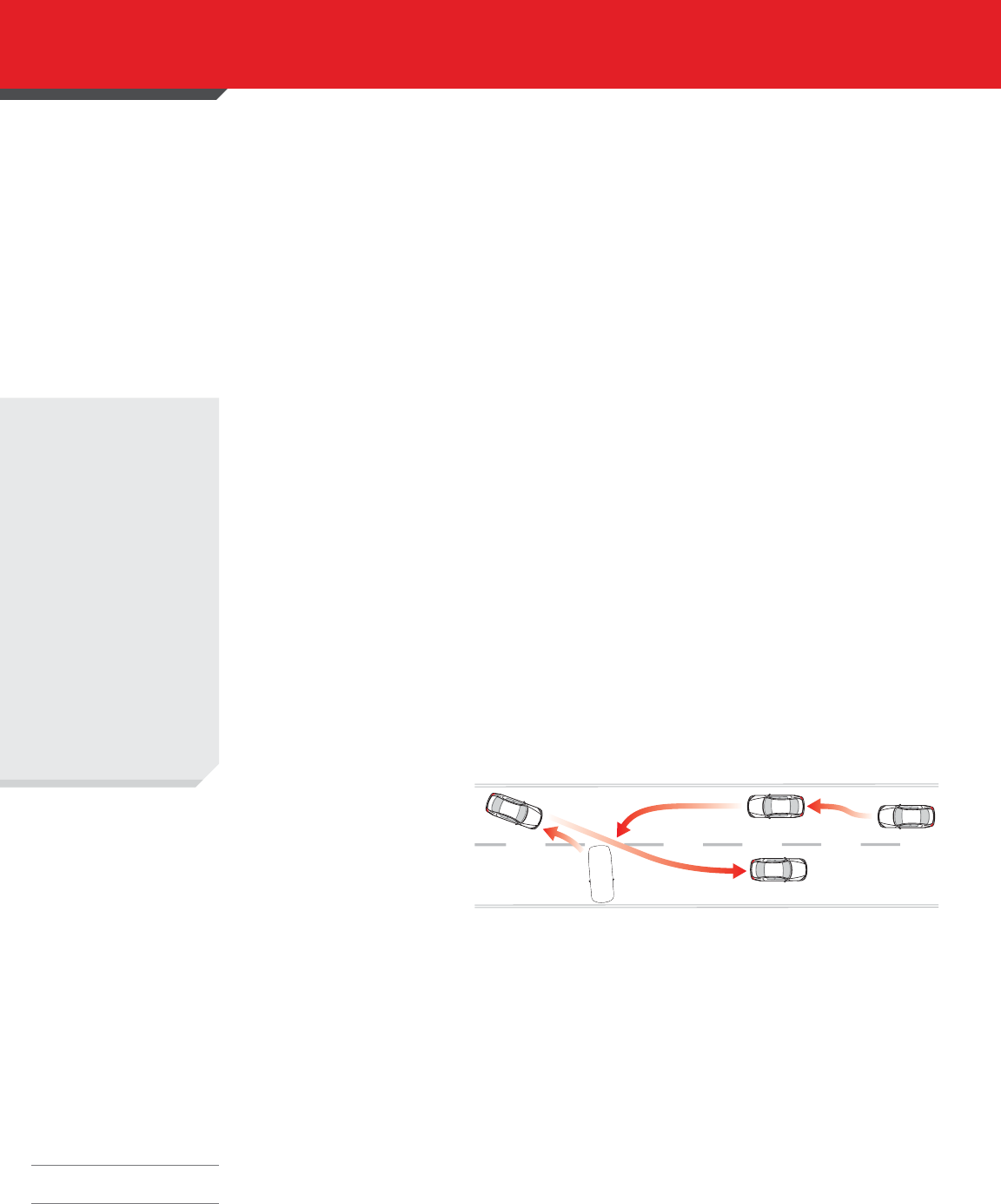
SKILL SEVEN
:
TURNING AROUND
Legal U-turns
U-turns are illegal in
many locations. Make
sure you and your teen
only practice legal
U-turns. U-turns should
never be made across
a double yellow line or
where a sign indicates
that they are prohibited.
In Nevada, U-turns are
also prohibited in active
school zones, on curves
or near a grade where
there is less than 500 feet
of visibility.
Skill completed
supervisor initials
driver initials
#RoadReady
Turning around
Goal: Teach your teen the best ways to turn a vehicle around in various circumstances.
Location: Start on a quiet neighborhood street with accessible driveways. Please be respectful of
neighbors and private property. Move to a multi-lane road for U-turns, if legally allowed in your area.
Lesson one – turning around safely
Start by coaching your teen that the safest and easiest way to turn around is to drive around the block.
The less backing up, the better! Since that’s not always possible, it’s important to practice other ways to
turn around.
Lesson two – two-point turns
A two-point turn involves backing into a driveway to reverse direction. On a quiet street, have your
teen identify an available driveway on the same side of the street as your car, at a point where they
can see oncoming trafc for at least 200 feet.
• Pull just ahead of the driveway, making sure there is no trafc behind the car, and signal.
• Make sure the road is clear behind the car and the driveway, put the car in reverse, and then
back into the driveway.
• Shift back into drive and check the road for approaching trafc from both directions.
• When it’s clear, turn back onto the road.
Lesson three – three-point turns
This more challenging turn should only be done when there is no available driveway. Three-point turns
block both sides of a two-lane road, so coach your teen to make absolutely sure that the trafc is clear in
both directions:
• Pull as far to the right as
possible to maximize room
to maneuver.
• Turn sharply across the
road
➊
until the car is
perpendicular, facing the curb.
• Continue checking for trafc
in both directions.
• Put the car in reverse
➋
and back up, turning sharply in the other direction, into the original lane,
but now facing the opposite direction.
• Shift into drive and pull forward
➌
into the correct lane, driving straight ahead.
Lesson four – legal U-turns
First explain that U-turns can be very dangerous, and should only be done where they are legal.
• Begin the U-turn in the left lane, closest to the center line or median.
• Be sure there is enough room to make the turn without hitting the curb or any parked cars.
• Signal to indicate the direction of the turn, checking carefully for trafc in both directions.
• Move forward, turning the wheel sharply to turn around.
• Finish the U-turn in the opposite direction and accelerate to an appropriate speed.
➊
➌
Practice two-point and three-point turns at least 10 times each.
➋
13
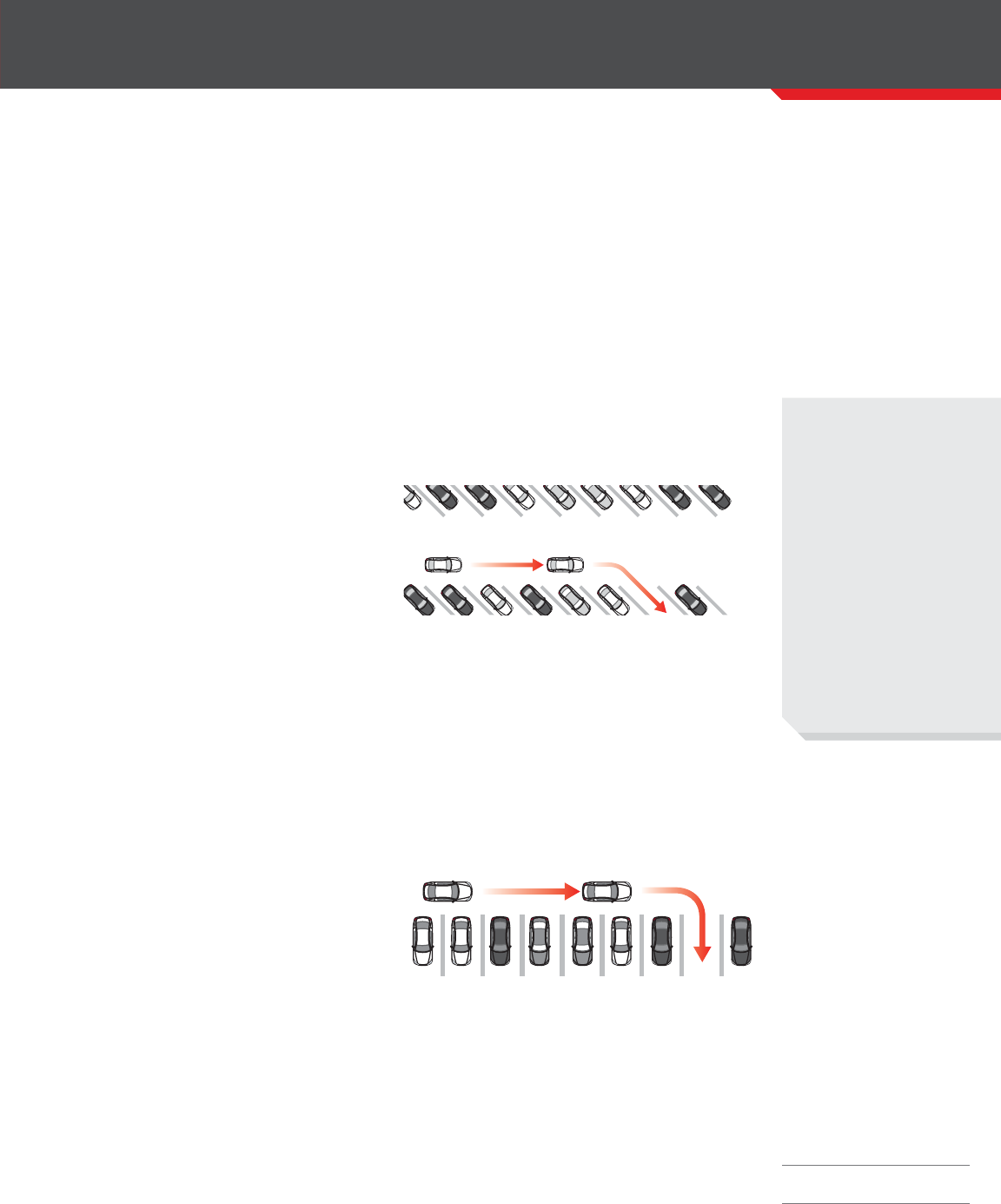
SKILL EIGHT
:
PARKING – PART ONE
Parking – part one
Goal: Teach your teen to master angle and perpendicular parking.
Location: Start in large, level, mostly empty areas. You will need angled and perpendicular spaces.
Before your teen starts parking practice, review “Skill Three: How Close Are You?”
and “Skill Four: Backing Up.”
Lesson one – angle parking
The gentler turn makes this the easiest type of parking for new drivers.
Hint: Choosing a parking spot on the left side of the car can provide more room to maneuver
and a better view of trafc when backing out.
• Signal to indicate intent to turn into
a parking space.
• Move forward until the steering wheel is
aligned with the rst pavement line marking
the space.
• Look at the middle of the parking space
and turn the wheel sharply at a slow,
controlled speed.
Turn when the front of your vehicle reaches the edge
•
of the space. Stay alert for cars backing out to leave
Steer toward the center of the space,
straightening the wheel upon entry.
their space.
• Stop when the front bumper is six inches
from the curb or from the end of the space.
• After you’ve parked, put the gear in park for automatic transmissions (for manual transmissions,
put the car either in rst or reverse) and set the parking brake. Shut off the ignition and remove
the key. Check for trafc prior to getting out. Lock the doors.
• Suddenly opening car doors can pose a very serious threat to bicyclists. When opening your car door,
drivers and passengers are encouraged to check your rear-view mirror, side-view mirror, then open the
door with your far hand.
Lesson two – perpendicular parking
The steps are the same as angle parking, but
the sharper turn into perpendicular spaces may
require more practice.
Lesson three – exiting spaces
Turn when your outside mirror reaches the edge of
With a foot on the brake, shift into reverse,
which will signal that you will be backing up.
your car centered in the space.
•
the space. Always nish with your wheels straight and
• Before moving, search all around your vehicle
using your mirrors, backup camera, and looking over your shoulder side-to-side and behind.
• For angled spaces, back up straight until the driver’s seat is even with the bumper of the next vehicle
on the turning side. For perpendicular spaces, back up straight until the windshield is aligned with the
bumper of the next vehicle.
• Quickly turn the wheel in the direction that the rear of the car needs to go.
• Glance forward to make sure the front bumper is clear of the car on the other side.
• When the front bumper clears the other vehicle, stop, shift into drive, and pull forward to
complete the exit.
Practice makes
perfect
Plan to spend a good
amount of time on
parking practice with your
teen — it’s a difcult skill
to learn. Many crashes
happen in parking lots,
and mastering parking
skills is an important way
to help avoid collisions.
Have your teen practice
angle and perpendicular
parking 15–20 times each.
Skill completed
supervisor initials
driver initials
#RoadReady
14

SKILL EIGHT
:
PARKING – PART TWO
Parallel parking is a difcult maneuver for new drivers, so patience is key. Many drivers never learn to do
it well, especially in areas where it’s not common. Because of the difculty of learning parallel parking,
and because there are several different teaching methods, this skill is sometimes best taught by a
professional driving instructor. Assess your own parallel parking skills and your teen’s abilities
before beginning.
• Select an available space on the
passenger’s side of the car.
• Signal when approaching the space and check
mirrors for trafc behind the vehicle.
• Move forward past the space until lined up
directly parallel to the car parked in front, 2–5
feet away. Being too close or too far
away will make parking more difcult.
• With a foot on the brake, shift to reverse
and turn around to check for trafc and
make sure the travel path is clear.
Start by practicing with cones before graduating to
Have patience
When practicing parallel
parking, your teen will
probably hit the curb
several times. Tell them
not to worry — even the
best parallel parkers do
this sometimes. Coach
them to pull out of the
space and try again,
adjusting their turning
angle as needed.
Parking – part two
Goal: Teach your teen to master parallel parking.
Location: A street with marked parallel parking spaces at a time of day when trafc is light.
Lesson one – parallel parking
practicing alongside vehicles.
• Release the brake, start backing up slowly,
and start to make an “S” turn, turning rst
right and then left.
• Glance both forward and backward repeatedly to check the space around the car while turning.
• Once the rear of the car is mostly in the space, start turning in the other direction to straighten out.
• Adjust the vehicle’s position as needed to center it in the space.
• Check to see if the wheels are no more than 18 inches from the curb. If not, pull out and try again.
• Always check for passing vehicles and cyclists before you open your door.
Lesson two – exiting a parallel parking space
• With a foot on the brake, shift to reverse, turn around, and back as close as possible to the vehicle
behind you.
• Check your side mirror and look over your shoulder for cyclists or fast-moving cars, then signal, and
shift into drive.
• Make sure the travel path is clear, then move slowly forward while steering rapidly out of the space.
Lesson three – parallel parking on a hill
Make sure the vehicle is in park and the parking brake is properly engaged. To prevent the vehicle from
rolling into trafc, instruct your teen to turn the front wheels as follows:
Skill completed
• Toward the curb when parking downhill
• Away from the curb when parking uphill
supervisor initials
If there is no curb, have your teen point the wheel so that the car would roll away from trafc if it moved.
driver initials
#RoadReady
15

NEVADA DEPARTMENT OF MOTOR VEHICLES
Nevada teen driver laws
Getting your full license
To obtain a driver’s license, any new driver under age 18 must:
• Complete a 30-hour driver’s education course (minimum enrollment age is 15). Submit the Certificate of Completion at the
skills test. Teens in rural areas where a driver education course is not offered within 30 miles of their residence, and who
cannot access a course online, may substitute an additional 50 hours of behind-the-wheel experience for the course.
• Complete 50 hours of behind the wheel experience, including 10 hours at night.
• Keep a log of the dates and times of this experience on the official DMV Beginning Driver Experience Log (Form DLD-130), or
on the RoadReady® mobile app. Submit the completed form or the printed RoadReady® log at the skills test.
• Be 16 years of age and have held an instruction permit for a minimum of six months.
• Have no at-fault accidents, moving violation convictions or any type of drug or alcohol conviction within six months.
• Pass the driving skills test.
After the skills test
The following restrictions apply after a driver under age 18 has received a full license:
• The driver may not transport passengers under age 18, except immediate family members, for the first six months.
• The driver may not drive between the hours of 10 p.m. and 5 a.m. unless they are traveling to or from a scheduled event such
as work or a school event. This curfew applies to all drivers under 18 until they turn 18.
• The parent or guardian who accepted financial responsibility for the new driver may cancel the instruction permit or license
at any time. The underage driver is required by law to surrender the license to the DMV.
• Schools may suspend an underage driver’s license or delay its issuance if the student is declared a habitual truant.
• Courts may revoke or suspend an underage driver’s license or delay its issuance for any of the same reasons as adult drivers,
and for criminal convictions related to alcohol, controlled substances or firearms.
16

NEVADA DEPARTMENT OF MOTOR VEHICLES
Supervised driving log
Parents or guardians are responsible for making certain that their teen has completed no less than 50
hours of supervised driving, with 10 of those hours completed at night.
The 50 hours can be completed with any licensed driver who is at least 21 years old and has been
licensed at least one year.
The experienced driver must be seated next to the beginning driver.
You must submit a log of the driving experience. This can be completed on the ofcial Beginning Driver
Experience Log (DLD-130) or you may submit the printout from the RoadReady
®
app.
RoadReady
®
is a valuable tool that will help you keep track of time spent on the road, and will ensure
that your teen has a diverse supervised driving experience. You want your teen to be as prepared as
possible for their driving skills test, and more importantly, to drive safely on their own.
WITH SUPPORT FROM
GDL systems
Nevada’s Graduated
Driver Licensing (GDL)
laws are intended to
provide teen drivers with
practice under the safest
conditions, exposing
them to more situations
only as their skills and
experience grow.
DOWNLOAD
OUR FREE
MOBILE APP
17

NRS 483.2521
Must be completed prior to arriving for the drive test appointment
________________________________________________ _______________________________________
SUPERVISED DRIVING LOG
LOG YOUR DRIVES ON THE FORM BELOW
OR DOWNLOAD THE FREE MOBILE APP
Field Services Division
Reno/Sparks/Carson City (775) 684-4DMV (4368)
Las Vegas Area (702) 486-4DMV (4368)
Fax: (775) 684-4992
dmvnv.com
Beginning Driver Experience Log -
NRS 483.2521
Must be completed prior to arriving for the drive test appointment
Applicant’s Name Instruction Permit or Restricted License No.
1. Beginning drivers under 18 years of age must complete 50 hours (3,000 minutes) of supervised driving experience in a
motor vehicle as a condition of receiving a full driver license. Ten hours (600 minutes) of this experience must be
completed in darkness. If applying for a motorcycle license only, all 50 hours must be completed during daylight hours on a
motorcycle.
2. There are three options for meeting the driver’s education requirements:
• Take a driver’s education course at any locally offered and DMV approved school;
• Take driver’s education on-line with a DMV approved school; or
• In rural areas where a driver course is not offered within a 30-mile radius of the beginning driver’s
residence, and it is not possible for you to access the internet for a driver’s education class, you must
complete 100 hours (6,000 minutes) of supervised experience, 10 hours (600 minutes) of which must be
completed in darkness. If applying for a motorcycle license only, all 100 hours must be completed during daylight
hours on a motorcycle.
3. Beginning drivers and their parent or guardian are required to keep a log of the dates and times of the supervised
experience using the reverse side of this form. Please document your driving experience at each occurrence using blue or
black ink. No gel pens or pencil will be accepted. Use additional log sheets as necessary.
4. All completed log sheets and a Certificate of Completion of a driver education course (if required) must be
submitted prior to the driving skills test.
Parent/Legal Guardian Certification of Behind-The-Wheel Driver Experience
I, the undersigned, do hereby certify that I am the __________________________________, of the person named above,
Relationship
and that he/she has completed the required number of hours of behind-the-wheel driving experience with a restricted
license, instruction permit or restricted permit issued pursuant to NRS 483.267, 483.270 or 483.280.
______________________________________ __________________ ________________
Signature of Parent/Legal Guardian License/ID Number Date
_________________________________________________________________________________ _____________________
Signature of Notary Public or Field Services Representative Date
FOR DEPARTMENT USE ONLY
Type of School Name of School Date of Completion
Professional Driving School_______________________________________________________________
Public/Private School_______________________________________________________________
Certificate Number, if applicable _______________________________________________
Certification Not Required
Transfer valid license from: State _______ Class __________________________________ Expiration Date _____________
Live in rural area where course is not offered. County/ City ________________________
Signature of Field Service Representative ____________________________________ Date ___________
DLD130(1/2019) Signatures must be originals. Photocopies are not acceptable.
Changes may not be made to this form once it is signed.
18

–
–
- -
Must be completed prior to drive test appointment
________________________________________________ _______________________________________
SUPERVISED DRIVING LOG
LOG YOUR DRIVES ON THE FORM BELOW
OR DOWNLOAD THE FREE MOBILE APP
Beginning Driver Experience Log
Must be completed prior to drive test appointment
Applicant’s Name Instruction Permit or Restricted License No.
• This log, and any additional sheets, must be completed in blue or black ink.
• No pencil or colored gel pens will be accepted
• Logs completed using military time will not be accepted.
Please enter the date, start time/ end time, to include AM or PM. Enter the number of minutes during each drive
session on a separate line.
Column A Daytime Driving
Column B Nighttime Driving
Time of Day
Date
Please indicate AM or PM
Minutes
Do not use military time
Begin
End
Time of Day
Date
Please indicate AM or PM
Minutes
Do not use military time
Begin
End
8/10/07
8:00 pm 9:00 pm 60
EXAMPLE
08/09/07
EXAMPLE
6:00 am 8:00 am 120
Subtotal Column B
Subtotal Column A
Minutes Subtotal from Additional Sheets
Total Minutes
Total Hours (Divide Total Minutes by 60)
/
Subtotal Column A Minutes Grand Total Minutes/Hours
/
19
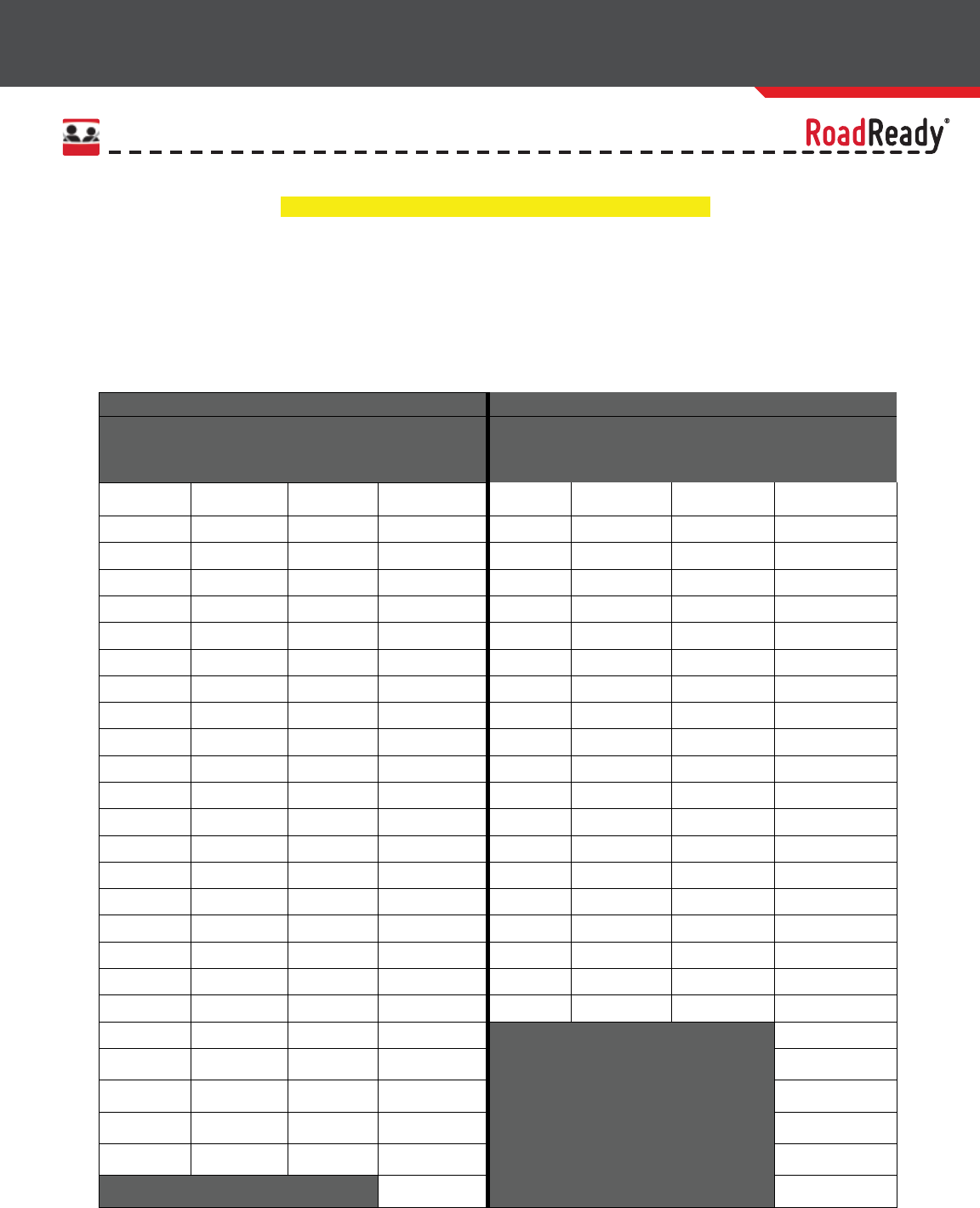
–
–
- -
Must be completed prior to drive test appointment
________________________________________________ _______________________________________
SUPERVISED DRIVING LOG
LOG YOUR DRIVES ON THE FORM BELOW
OR DOWNLOAD THE FREE MOBILE APP
Beginning Driver Experience Log
Must be completed prior to drive test appointment
Applicant’s Name Instruction Permit or Restricted License No.
• This log, and any additional sheets, must be completed in blue or black ink.
• No pencil or colored gel pens will be accepted
• Logs completed using military time will not be accepted.
Please enter the date, start time/ end time, to include AM or PM. Enter the number of minutes during each drive
session on a separate line.
Column A Daytime Driving
Column B Nighttime Driving
Time of Day
Date
Please indicate AM or PM
Minutes
Do not use military time
Begin
End
Time of Day
Date
Please indicate AM or PM
Minutes
Do not use military time
Begin
End
8/10/07
8:00 pm 9:00 pm 60
EXAMPLE
08/09/07
EXAMPLE
6:00 am 8:00 am 120
Subtotal Column B
Subtotal Column A
Minutes Subtotal from Additional Sheets
Total Minutes
Total Hours (Divide Total Minutes by 60)
/
Subtotal Column A Minutes Grand Total Minutes/Hours
/
20

–
–
- -
Must be completed prior to drive test appointment
________________________________________________ _______________________________________
SUPERVISED DRIVING LOG
LOG YOUR DRIVES ON THE FORM BELOW
OR DOWNLOAD THE FREE MOBILE APP
Beginning Driver Experience Log
Must be completed prior to drive test appointment
Applicant’s Name Instruction Permit or Restricted License No.
• This log, and any additional sheets, must be completed in blue or black ink.
• No pencil or colored gel pens will be accepted
• Logs completed using military time will not be accepted.
Please enter the date, start time/ end time, to include AM or PM. Enter the number of minutes during each drive
session on a separate line.
Column A Daytime Driving
Column B Nighttime Driving
Time of Day
Date
Please indicate AM or PM
Minutes
Do not use military time
Begin
End
Time of Day
Date
Please indicate AM or PM
Minutes
Do not use military time
Begin
End
8/10/07
8:00 pm 9:00 pm 60
EXAMPLE
08/09/07
EXAMPLE
6:00 am 8:00 am 120
Subtotal Column B
Subtotal Column A
Minutes Subtotal from Additional Sheets
Total Minutes
Total Hours (Divide Total Minutes by 60)
/
Subtotal Column A Minutes Grand Total Minutes/Hours
/
21
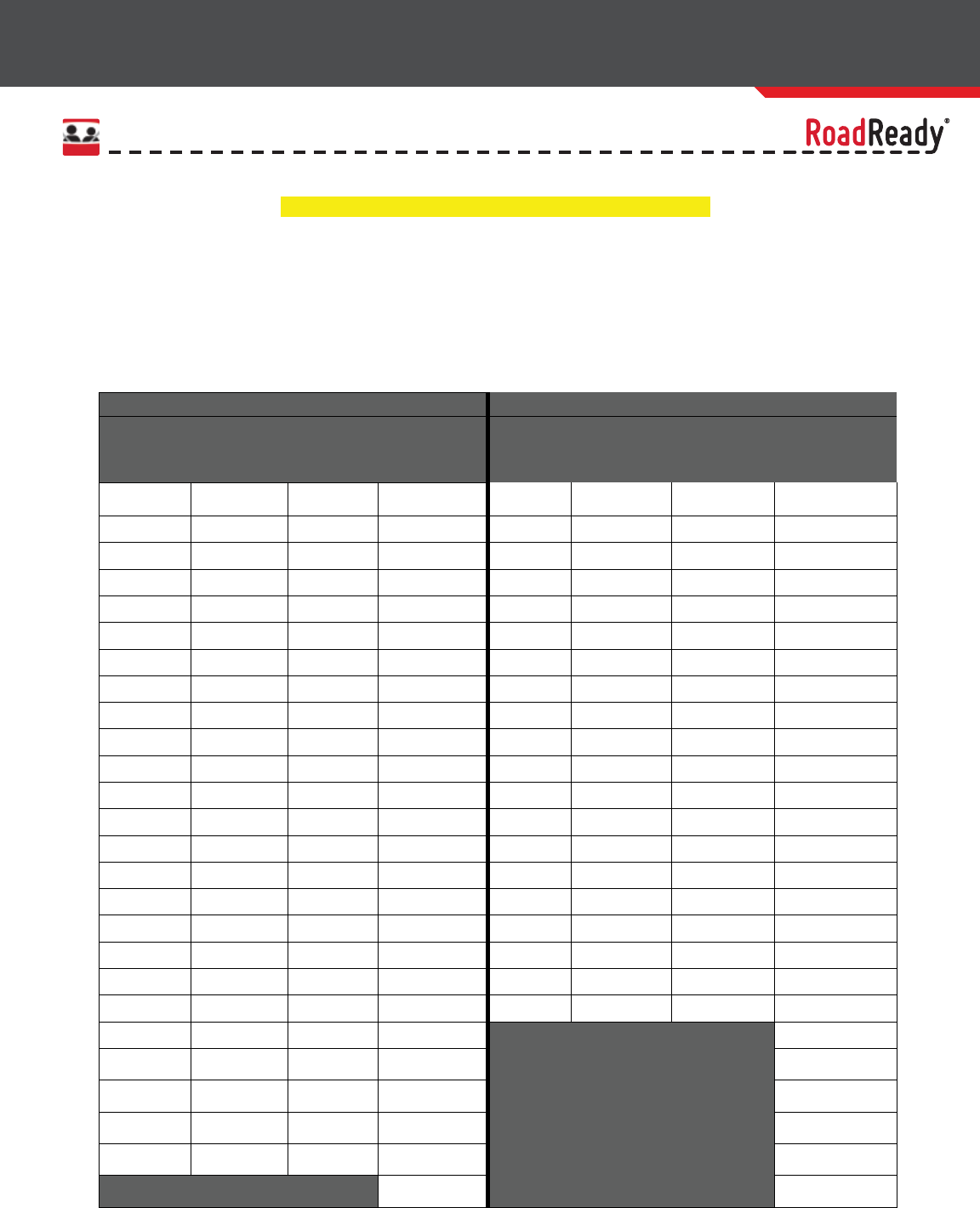
–
–
- -
Must be completed prior to drive test appointment
________________________________________________ _______________________________________
SUPERVISED DRIVING LOG
LOG YOUR DRIVES ON THE FORM BELOW
OR DOWNLOAD THE FREE MOBILE APP
Beginning Driver Experience Log
Must be completed prior to drive test appointment
Applicant’s Name Instruction Permit or Restricted License No.
• This log, and any additional sheets, must be completed in blue or black ink.
• No pencil or colored gel pens will be accepted
• Logs completed using military time will not be accepted.
Please enter the date, start time/ end time, to include AM or PM. Enter the number of minutes during each drive
session on a separate line.
Column A Daytime Driving
Column B Nighttime Driving
Time of Day
Date
Please indicate AM or PM
Minutes
Do not use military time
Begin
End
Time of Day
Date
Please indicate AM or PM
Minutes
Do not use military time
Begin
End
8/10/07
8:00 pm 9:00 pm 60
EXAMPLE
08/09/07
EXAMPLE
6:00 am 8:00 am 120
Subtotal Column B
Subtotal Column A
Minutes Subtotal from Additional Sheets
Total Minutes
Total Hours (Divide Total Minutes by 60)
/
Subtotal Column A Minutes Grand Total Minutes/Hours
/
22
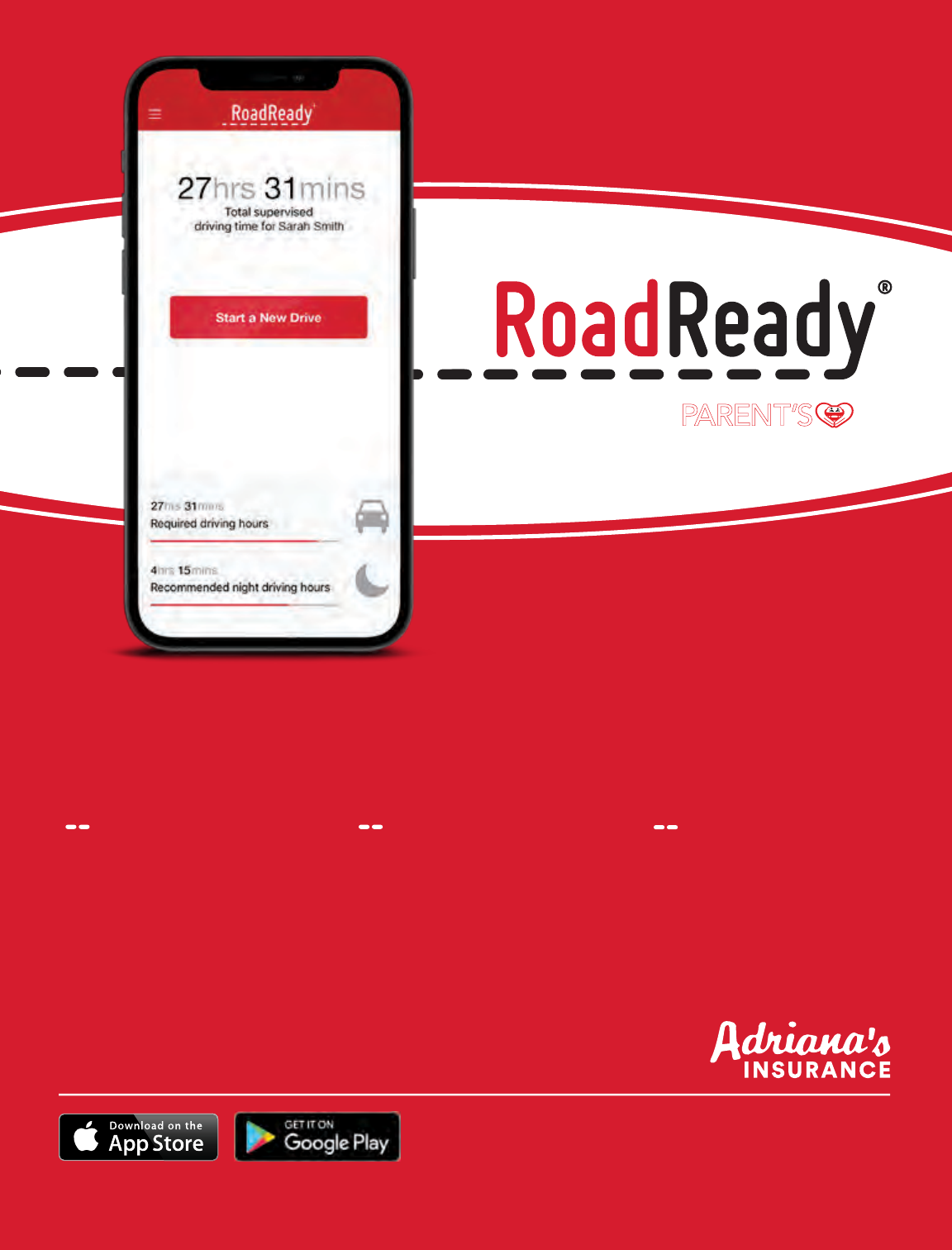
Download our FREE mobile app
to log your Learner’s Permit practice driving.
SYNC
Connect one teen driver’s
practice drive time across
mutiple phones by using
the same log-in on each
device.
SOCIAL
Share drives and
accomplishments with
friends on social networks
with RoadReady’s social
sharing options.
@PSDP_Info thank you!
I love this app so much.
- Twitter Follower
WITH SUPPORT FROM
SMART
Log your drives, including
driving conditions (road
type and weather), driving
notes, state requirements
& more.
LEARN MORE AT ROADREADYAPP.COM
Apple, the Apple logo and iPhone are trademarks of Apple Inc., registered in the U.S. and other countries. App Store is a service mark of Apple Inc.
Google Play and the Google Play logo are trademarks of Google LLC.
A component of the
PARENT’S
Supervised Driving Program

SKILL NINE
:
DRIVING ON RURAL ROADS
Driving on rural roads
Goal: Teach your teen to drive safely and with condence on two-lane rural roads.
Location: A two-lane rural road.
Lesson one – gravel roads
Gravel roads: Gravel roads present their own special road safety challenge. The issue is traction; driving
on loose gravel is harder than driving on pavement because your tires don’t have the traction needed
to give you stable control. Slow down, avoid sudden turning, accelerate and brake slowly, and increase
your following distance to six seconds. Be particularly aware of gravel “windrows,” piles of gravel near
the road edge used for highway maintenance.
Lesson two – driving hazards
Large/slow vehicles: Slower trucks, farm vehicles, and road maintenance equipment are likely to
make wide turns at unmarked entrances. Use caution and make sure the driver can see your vehicle
before passing.
Sharp drop-offs and gravel shoulders: One of the most common driving hazards is running off the
road. The urge to overcorrect is strong and often results in a serious crash. If you run off the road,
follow these steps to ease your vehicle back onto the road:
• Do not turn the wheel; continue driving straight
• Take your foot off the accelerator
• Find a safe place to reenter the road
• Turn on your turn signal and reenter the road when it is clear
• In general, try to not apply brakes until regaining control of the vehicle
Restricted visibility: Trees, cornelds, buildings, and hills can block a driver’s view of oncoming
trafc, or trafc entering from the side. Identify blind spots to better anticipate and be prepared
for potential dangers.
Uncontrolled intersections: These are intersections not controlled by signs, signals, or pavement
markings. Use caution, slow down, and check both ways twice. Proceed cautiously once there is no
oncoming trafc.
Animals: If unable to stop for an animal crossing the road, do NOT swerve — swerving makes it
hard to keep control. The most serious crashes happen when drivers swerve into oncoming trafc
or roll into a ditch.
If you see an animal, slow down and be prepared to stop. Always be on the lookout, especially at sunrise
and sunset. October and November are peak months for deer crashes — the most common type of
crash. Deer travel in groups; if you see one, look for more.
Hills and curves: These are often steeper and sharper on rural roads than on highways. Before
reaching the crest of a hill, or entering a curve, slow down, move to the right side, and watch
for trafc.
Railroad crossings: Always slow down, look both ways, listen, and be prepared to stop. On rural
roads, many railroad crossings are marked only with a round yellow ‘railroad crossing ahead’ warning
sign and a white X-shaped railroad crossing. There may not be ashing lights, warning bells, crossing
gates, or pavement markings. It is difcult to judge the speed of a train, so before you cross, make
sure you don’t see or hear a train either direction.
Gravel slide
Be ready for skids.
A vehicle can become
difcult to handle in
heavy gravel. If the
vehicle starts to skid,
release the accelerator
or brake. As you release
them, look where you
want to go, and steer
in that direction.
Skill completed
supervisor initials
driver initials
#RoadReady
24

SKILL TEN
:
MULTI-LANE ROADS – PART ONE
Other road users
Motorcyclists, bicyclists,
and pedestrians are more
difcult to see than cars
because they are smaller
— and drivers tend to
focus on looking only for
cars. Trafc, weather, and
road conditions require
cyclists to react differently
than car drivers. It can be
difcult for young drivers
to judge and predict
their actions. Always
give motorcyclists and
bicyclists a wide berth
and reduce your speed.
Skill completed
supervisor initials
driver initials
#RoadReady
Multi-lane roads – part one
Goal: Teach your teen to drive safely and with condence on busier, more complex, multi-lane roads.
Location: A busier, multi-lane road. When beginning, choose a time with limited trafc, such as a
weekend morning.
Skill review
By now, your teen should be comfortable driving on quiet roads. Before starting multi-lane road
practice, it’s important to review some key information from previous lessons. The following skills are
crucial to safe driving on busier, more complicated roads.
Lesson one – mirror positioning, monitoring and blind spots
Refer to Skills one and two. Clearly seeing the adjacent trafc is especially important on multi-lane
roads. Remind your teen to check the mirror positions when entering the car, and to constantly monitor
the trafc around them.
Lesson two – stopping distance
Refer to Skill six. Remind your teen that when stopping their vehicle behind another one, they should
be far enough back to see where the other car’s tires meet the road.
Lesson three – following distance
Refer to Skill six. Review the four-second rule with your teen, emphasizing that increasing following
distance is the single best way to reduce crash risk. This gives the driver visibility, time, and space to
avoid crashes.
Lesson four – safe lane changing
First, coach your teen not to change
lanes unnecessarily. Studies show that
while it may not look like it, most travel
lanes ow at around the same rate.
Changing lanes in an effort to save time
doesn’t actually save time, but it does
increase crash risk.
Ask your teen to list valid reasons to
change lanes. Good answers include:
to make a turn, to avoid an obstacle,
to exit the road, to park, or to pass
another vehicle.
Have your teen practice these lane
change steps until procient:
When changing lanes, always recheck trafc with a glance over
• Check trafc to the rear and the sides
the shoulder at the blind spot.
for an appropriate gap.
• Signal to indicate intention to change lanes at least 100 feet ahead on city streets or 300 feet ahead on
open highways.
• Recheck trafc, including a glance over the shoulder at the mirror blind spot area.
• Maintain speed or accelerate slightly before and during the lane change.
• Gradually move into the new lane.
• Adjust following distance, using the four-second rule.
25

SKILL TEN
:
MULTI-LANE ROADS – PART TWO
Multi-lane roads – part two
Goal: Teach your teen to drive safely and with condence on busier, more complex, multi-lane roads.
Location: A busier, multi-lane road. Choose a time with limited trafc, such as a weekend morning.
Lesson one – right turns
Start with right turns, which are fairly simple. Right turns are always made from the right lane of the
current road to the rst, open lane of the new road. Look for signs and signals that indicate whether
“right on red” is allowed. Practice right turns until you feel condent that your teen is procient.
Lesson two – left turns
Left turns should almost always begin and end in the closest lane to the right of the yellow line. The
yellow line in the lane being turned into should be your teen’s target. There are three types of left turns:
• Protected left turns with a designated left turn lane and left turn signal
• Semi-protected left turns made from a center or shared turn lane
• Unprotected left turns made from an active travel lane
Protected left turns should be made from the designated lane when the left turn signal displays
a green arrow, using the yellow line in the lane being turned into as the steering target.
For unprotected left turns, coach your teen on
these steps:
• Make sure the vehicle is in the correct lane to make a
left turn.
• Signal the turn and begin slowing down at least 100
feet from the intersection.
• Move carefully into the intersection. Don’t turn the
Don’t turn the wheel until you’re ready to make
wheel until you’re ready to make the turn.
the turn.
• Yield to any vehicles, cyclists, or pedestrians.
• When there is sufcient space with no oncoming trafc, move ahead into the turn.
• Choose a steering path line in the middle of the closest lane to the right of the yellow line.
Lesson three – safe passing procedures
Discourage your teen from passing other cars unnecessarily. If passing is necessary, the following
steps should be observed:
• Position your vehicle more than four seconds behind the vehicle to be passed.
• Do not attempt to pass if a curve or hill is blocking your view of the road ahead, if you are within 100
feet of a street or railroad crossing or if lane markings or signs prohibit passing.
• You may pass on the right only if the street or highway is clearly marked for two or more lanes of trafc
moving in the same direction, and it is safe.
• Check the oncoming travel ahead to make sure there’s plenty of space before you try to pass.
• Check mirrors and blind spots for trafc behind you.
• Signal intent to pass and accelerate quickly to match the speed of trafc ow.
• While passing, monitor the space in front of and behind your vehicle and check the rearview mirror
for the front of the car being passed. Make sure to not exceed the speed limit when passing.
• When you see the front of the passed car in the rearview mirror and your vehicle is well clear, signal
intent, gently and slowly move back to the original lane, cancel the signal, and maintain speed.
Making left turns
Left turns are one of
the hardest maneuvers
for teens to master. Be
patient. New drivers often
have difculty judging
the speed and distances
of multiple lanes of
oncoming trafc. Practice
judging oncoming
vehicles’ distance from
your vehicle by counting
out loud the time it takes
for them to reach your car
from a designated point.
Skill completed
supervisor initials
driver initials
#RoadReady
26

SKILL ELEVEN
:
CITY DRIVING – PART ONE
Scan rst
Keep reminding your
teen that constant
awareness and looking
ahead are the keys
to learning to drive
safely on city streets.
Emphasize the idea that
a green light means,
“Scan the intersection
rst, then go.”
Skill completed
supervisor initials
driver initials
#RoadReady
City driving – part one
Goal: Teach your teen to drive safely and condently in the complex environment of city driving.
Note: City driving takes hundreds of hours, if not several years, to master.
Location: Busy, urban streets. Start at times when trafc is light, moving on to heavier trafc times as
your teen gains practice.
Skill review
Since the busy, crowded environment of city driving is challenging for new drivers, this is a good time
to review key driving skills. One of the most important skill for drivers is the ability to make good
decisions. City driving forces drivers to make lots of decisions quickly. The three things they need to
drive safely in the city are:
• Visibility: To see potential problems in all directions
• Space: To maneuver around obstacles and avoid hazards
• Time: To anticipate risks and make adjustments to speed or position
Lesson one – maximizing visibility and space
As you practice, have your teen focus on
making decisions that will maximize visibility
and space around the vehicle, increasing the
available reaction time.
• Looking ahead (refer to Skill six):
Congested city driving leaves very little
room for error. Identifying and anticipating
potential problems is crucial.
• Covering the brake: Coach your teen
that when they spot a hazard, they should
“cover” the brake by taking their foot off
the accelerator and holding it over the
brake. This will prepare them to slow down
or stop suddenly. Make sure they don’t
“ride” the brake. Riding the brake confuses other drivers and puts unnecessary wear on the brakes.
Lesson two – identifying hazards
As you begin city driving practice, have your teen drive through several blocks to identify and name
common hazards on busy, congested streets. Ask them to describe how they will safely deal with each
hazard they identify.
Such hazards may include:
• Parked cars, cars entering or exiting parking spaces, and car doors opening
• Delivery trucks stopping suddenly, with drivers racing to and from the trucks
• Buses making frequent stops, loading and unloading passengers
• Blind alleys, with cars or cyclists darting out
• Pedestrians and cyclists moving unpredictably, crossing streets illegally, etc.
• Limited visibility and intersections spaced at shorter intervals
• Aggressive drivers competing for lane space and parking spots
• Stop-and-go trafc ow
Looking ahead, identifying and anticipating potential
problems is crucial for safe driving.
27

SKILL ELEVEN
:
CITY DRIVING – PART TWO
City driving – part two
Goal: Teach your teen to drive safely and condently in the complex environment of city driving.
Note: This is not a goal that will be achieved in a single session. Spend as much time as possible with
your teen practicing safe city driving skills.
Location: Busy urban streets. Start at times when trafc is light, moving on to heavier trafc times as
your teen gains practice.
Lesson one – avoiding obstacles
Focus on lane position to avoid obstacles: City driving involves many circumstances in which travel
lanes are shared, congested, and partially or fully blocked. During practice sessions on busy city roads,
have your teen identify these steps to safely avoid obstacles:
• Identify right-lane obstacles, such as stopped buses, parked cars, delivery trucks, and cyclists.
• Identify left-lane obstacles, such as vehicles waiting to make a left turn, or cars traveling in the
opposite direction drifting over the center line.
• Identify the least-congested travel lane. Hint: On a three-lane road, this is usually the center lane.
• Position the vehicle in the lane at the greatest distance possible from any obstacles.
It can be tempting to pass vehicles on congested streets, when obstacles or trafc volume slow trafc.
However, this can be dangerous, due to closely spaced intersections, irregular trafc ow, cars entering
and exiting parking spots, etc. Coach your teen to avoid passing on busy city streets.
More is better
City driving skills take
a long time to acquire.
Spend as much time
and drive in as many
circumstances with your
teen (night, inclement
weather) as you are able.
Plan trips to less-familiar
places where you might
not normally travel.
Lesson two – deadly distractions
What happens inside the car can
be just as dangerous as what
happens outside. Engaging in
distracting activities while driving
can be deadly, especially for
young drivers. Ask your teen to list
dangerous driving distractions. Their
answers should include:
• Talking or texting, or dialing a phone
• Changing radio stations, shufing/
streaming music,
• Passengers, pets, or objects
moving in the car
• Eating, drinking, or smoking
• Searching for an item
• Intense or emotional conversations, or cognitive distractions, such a trying to solve a problem.
• Putting on makeup or looking in the mirror
Coach your teen to avoid distracting activities whenever possible, but especially in busy, congested
environments. Remind them to focus on keeping as much space as possible around the vehicle at all times.
Skill completed
Remind your teen to stay alert, scan their surroundings, and not
xate on any one thing.
supervisor initials
driver initials
#RoadReady
28

SKILL TWELVE
:
HIGHWAY DRIVING – PART ONE
Worthy of
repetition
Practice merging and
exiting many times, until
you feel condent that
your teen is procient.
Keep coaching your
teen that always being
attentive and looking
ahead are the keys to
learning to drive safely.
Skill completed
supervisor initials
driver initials
#RoadReady
Highway driving – part one
Goal: Teach your teen highway basics and how to safely enter and exit a highway.
Location: Start on a multi-lane highway with easily accessible exits, at a time when trafc is light, such as
a weekend morning. Move on to practice at heavier trafc times when your teen is ready.
Lesson one – observation
Before your teen gets behind the wheel on the highway, have your teen spend some time on highways
with you as the driver and your teen as the passenger. Emphasize the importance of looking ahead to
anticipate potential problems, and explain key highway features, such as:
• The different kinds of interchanges
• The meanings of highway signs and signals
• The meanings of different lane lines and markings
Lesson two – on-ramp segments
Explain the three segments of on-ramps, and how they’re used:
• Entrance area: The driver searches the highway and evaluates how much space they have to enter and
what speed is needed.
• Acceleration area: The driver brings the vehicle up to the speed of highway trafc ow.
• Merge area: The driver uses this space to merge into the trafc ow.
Lesson three – merging
Teach the steps for merging onto
a highway:
• Check for on-ramp speed signs.
• Before the entrance area, make quick
glances at the highway, scanning for
vehicles and entry gaps.
• In the acceleration area, signal to
show intent to enter the highway
and adjust speed to match the
trafc ow.
• In the merge area, enter the ow of trafc, checking mirrors and blind spots.
• Turn off the turn signal and begin looking ahead to anticipate problems or upcoming lane changes.
• Do not completely stop in the entrance area unless absolutely necessary.
Lesson four – exiting
Teach the steps for exiting a highway:
• Identify the exit well ahead of time.
• Search trafc for problems when approaching the exit, but don’t slow down on the highway.
• Start to signal four to six seconds before reaching the ramp.
• Upon entering the ramp, tap the brakes and begin to slow down to the posted exit ramp speed limit
before reaching the curve. On some ramps, be prepared to rapidly reduce your speed.
There is plenty of time to merge. If a gap doesn’t present itself
immediately, adjust your speed as early as possible in order to
nd one.
29
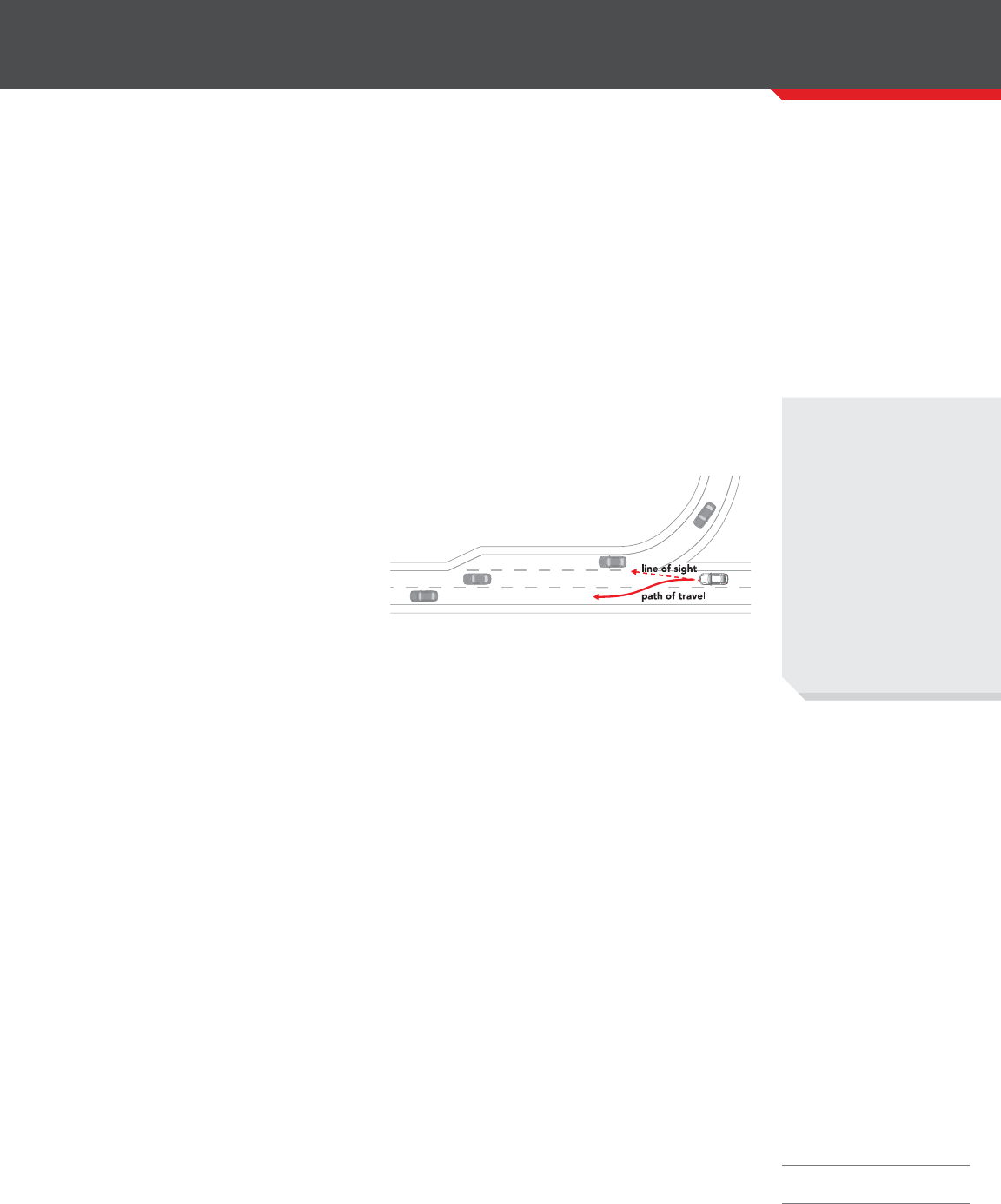
SKILL TWELVE
:
HIGHWAY DRIVING – PART TWO
Highway driving – part two
Goal: Teach your teen to maneuver safely in complex highway driving environments at higher speeds.
Location: Start on a multi-lane highway with easily-accessible exits, at a time when trafc is light, such as
a weekend morning. Move on to practice at heavier trafc times when your teen is ready.
Lesson one – steering technique
Once on the highway, coach your teen on steering technique. At fast highway speeds, excessive
steering can be dangerous and lead to loss of control. Remind your teen to steer gently on highways.
Lesson two – lane changing
In the high-speed, complex highway
environment, lane-changing skills are very
important. Have your teen spend lots of time
practicing the lane-changing and passing
skills previously learned in “Skill ten: multi-lane
roads” until they are comfortable performing
them at highway speeds. Remind your teen to:
• Watch for merging vehicles and move
one lane left to make space for them
when needed.
• Change lanes one at a time only.
• Watch mirrors for tailgaters and move to another lane to let them pass. Grow comfortable with
checking blind spots frequently to be aware of the trafc around you.
Lesson three – four-second rule
Review the four-second rule for following distance, learned in “Skill six: looking ahead”. At higher
speeds it’s recommended to add more following distance. Additionally, coach your teen to also use a
four-second rule for these highway driving circumstances:
• Merging onto a highway
• Changing lanes
• Exiting a highway
Lesson four – challenging road conditions
Coach your teen to adjust travel speed and vehicle position based on weather and road conditions.
Once your teen is comfortable with and procient at highway driving in good conditions, spend some
practice time on highways under more challenging conditions, such as rain. Coach them to always use
appropriate caution, as conditions can change quickly.
Lesson ve – road trips
Consider planning some short day trips with your teen to a destination two to three hours away. Have
them drive there and back. Find an event or place that you will both enjoy and have fun.
Lesson six – Nevada’s Keep Right law
Slow trafc keep right: Nevada law prohibits motorists from driving in the extreme left-hand lane of
a controlled-access highway if the driver knows — or should know — that he or she is being overtaken
by a vehicle traveling at a higher rate of speed. This does not apply to HOV lanes, nor within the
geographical limits of a city or town.
For the rst several lane changes you may need to talk
your teen through the decision-making process. Double-
check all mirrors to make sure that the lane is clear.
Higher order
Early in the training
process, parental
instruction tends to focus
on vehicle handling. As
your teen’s skills improve,
try to focus on “higher
order” instruction, such
as scanning ahead,
hazard detection, and
anticipating the other
driver’s behavior.
Skill completed
supervisor initials
driver initials
#RoadReady
30
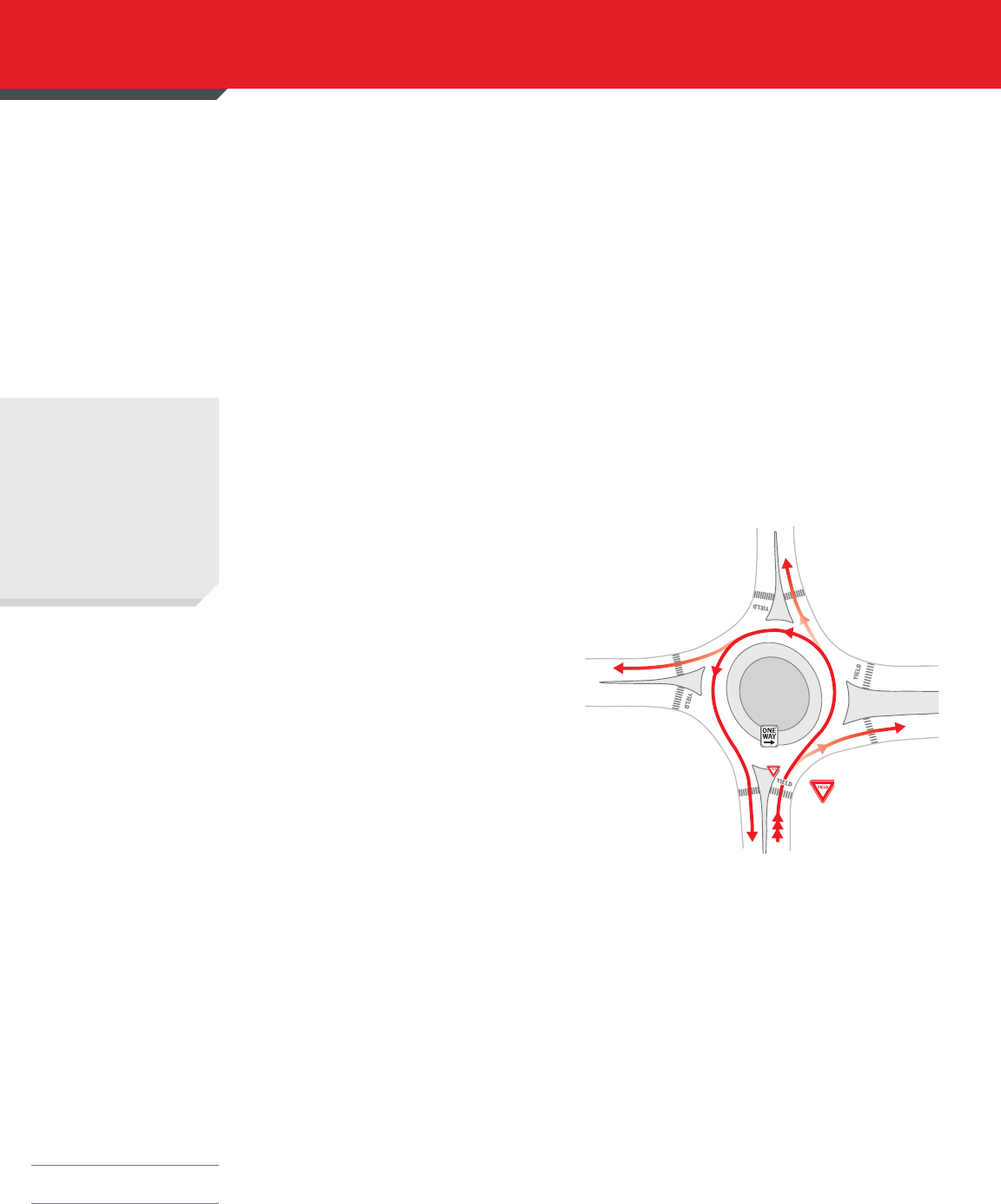
SKILL THIRTEEN
:
ROUNDABOUTS
Yield the
right-of-way
As a rule of thumb,
when entering or driving
through a roundabout,
always yield to trafc on
your left.
Skill completed
supervisor initials
driver initials
#RoadReady
Roundabouts
Goal: Teach your teen how to enter and drive roundabouts safely.
Location: A road that leads to a one-lane roundabout. Move on to practice at two or more lane
roundabouts when your teen is ready.
Roundabouts are circular intersections designed to calm trafc, increase safety, reduce stop-and-go
travel, and decrease trafc delays. They were introduced in Nevada in the early 1990s in Las Vegas.
Since then, roundabouts have proven to be an efcient means of moving trafc through congested
intersections and have shown to reduce crashes by half (all but eliminating the more severe broadside
and head-on collisions). Roundabouts also offer a safe environment for pedestrians, who only have to
navigate one-way trafc ow.
Driving in a roundabout can be intimidating, but it’s really quite simple when you know how it works.
Lesson one – ve easy steps
• Slow down: Speeds of 15 mph or less are
generally adequate in the roundabout.
• Yield: Vehicles entering must always yield to
cars already in the roundabout. Look to your
left for entering trafc.
• Entering: Don’t stop once inside the
roundabout. The vehicle in the roundabout
has the right of way. Do not change lanes
within the roundabout.
• Destination signs: Look for destination signs
and exit in that direction.
• Exiting: Look to your right, check your side
mirror and use your turn signal.
Lesson two – yield to emergency
vehicles
• If you have not entered the roundabout, pull
over and allow emergency vehicles to pass.
• If you have entered the roundabout, continue
to your exit, then pull over and allow
emergency vehicles to pass.
• Avoid stopping in the roundabout.
Lesson three – two or more lane roundabouts
• As you approach, observe the signs and arrows to determine which lane to use before entering.
• Signs on the side of the road and white arrows on the road will show the correct
lane to use.
• If you want to make a left turn, stay in the left lane or other lanes that are signed and marked as
a left turn.
• To make a right turn, stay in the right lane or other lanes that are signed and marked as a right turn lane.
• If you want to go straight, observe the signs and arrows to see which lane is correct.
This example shows the trafc movement patterns
through a one-lane roundabout. The one-lane
roundabout is known as one of the safest and most
efcient intersections.
Crosswalk:
Yield to Pedestrians
Yield to all traffic before entering roundabout
Traffic circulates
counterclockwise
in a roundabout
31

BEYOND THE BASICS
Adapting to new landscapes
Mountain driving
Some hazards you should be aware of are steep hills, changing weather, wildlife, and rocks in the
roadway. If your vehicle experiences difculty traveling up steep roadways, pull off the road at the
rst place you may do so safely, or stay in the right lane to allow other vehicles to pass. Here are some
added tips:
• Pay special attention to speed limit signs and warning signs, such as those warning of curves,
steep hills, or other hazards.
• Watch for bicyclists near the right edge of the road.
• Use a lower gear to control speeds while going up or down long, steep hills.
• You must yield to vehicles going uphill if you are traveling downhill on a narrow road.
• Do not coast downhill by shifting into neutral or disengaging the clutch.
The higher the altitude, the less oxygen there is in the air. Some people may react to the decrease
in oxygen. They may develop mild symptoms, such as headache, nausea, and fatigue. Remember,
insufcient hydration can lead to the onset of symptoms of altitude sickness. Even if they are mild, they
can affect your alertness as a driver.
Rural driving
When driving in rural or country areas, there are a number of special situations that require attention.
Watch for driveways, farm equipment, railroad crossings that might not be marked, and bridges that
are narrow and poorly surfaced. Some intersections may be hidden by trees, brush, and crops. Animals
often are found wandering along the roadway. Extra care and slower speeds should be used when
driving on gravel roads because of the reduced traction due to the road surface. The road surface
can be affected by loose gravel, slippery conditions after rain or snow, ruts in the driving lanes, or
washboard conditions. When approaching oncoming vehicles, watch for soft shoulders or the absence
of shoulders.
Safety around snowplows
Nevada Department of Transportation (NDOT) snowplows use distinctive lights to warn you that snow
removal operations are underway. When you see these lights, slow down and use caution.
• Give snowplows room to work: The plows are wide and can cross the center line or shoulder.
• Do not tailgate and avoid passing, especially on the right: If you must pass, be extremely cautious
and beware of the snow cloud.
• Keep your distance and watch for sudden stops and turns: A snowplow operator’s eld of vision is
restricted. You may see them, but they don’t always see you.
Four-wheel drive (4WD) vehicles do not stop faster on ice and snow than two-wheel drive (2WD) vehicles.
The heavier the vehicle, the longer it takes to stop, no matter which wheels are powered.
Overcondence
After becoming procient
in basic driving skills,
teens can become
overcondent and begin
to drive faster, follow
other cars more closely,
brake abruptly, etc.
Gently and continuously
remind your teen to stay
four seconds back from
other vehicles and always
drive with caution.
32

BEYOND THE BASICS
Keep on coachin’
Even after your teen is
licensed, use your time
driving with them to
instill habits of good
judgment, accurate
hazard anticipation, and
smart decision-making.
Remember that crash
rates are highest in the
rst months of licensure.
Your role is still vital even
after your teen receives
his or her license!
Continuing education
Learning doesn’t stop when your teen has received their license. It’s important to continue teaching
and building upon the skills they have learned. As you continue the supervision process, think about
these three areas of focus:
• Spend as much time as possible driving with your teen.
• Drive in a wide variety of conditions (weather, time of day, different trafc volumes, etc.).
• Focus on “higher level” learning: scanning ahead, recognizing hazards, and learning to anticipate
the behavior of other drivers.
Now that your teen has become procient in the basic operational skills of driving, it is essential that
they be exposed to a wide variety of driving circumstances and conditions. Make a point of driving
with them in different situations that they have not yet experienced, and do it for all types of roads
— quiet neighborhood streets, multi-lane roads, and highways. Drive with them at different times of
the day, in poor weather, and with varying levels of trafc. It’s much better that they experience these
conditions with you, rather than alone or with other teens.
Much of what has been discussed to this point has related specically to the basic skills your teen will
need to be a safe driver. Now, your goal is to ensure your teen is thinking intelligently and making
the right decisions as a driver. Sometimes after teens become procient with the basic skills, parents/
guardians will often “step back,” becoming less involved in their teen’s supervision. But there’s still a
lot to learn; their teen’s education is not complete.
Be clear with your teen that the training process is ongoing and that you will continue to provide input
into their development so that you both stay in the learning/teaching mode.
Even the best new drivers are likely to make mistakes. These mistakes are great teachable
moments for “higher order” instructions. So instead of saying, “Stop sooner,” advise your teen to
try to focus on looking ahead and anticipating events, with an emphasis on good judgment, good
decision making, and hazard perception. The shift from a basic comment to a more advanced focus is
perhaps the most essential element of educating your teen at this point in the learning process.
As your teen drives, talk to them about specic hazard areas, possible areas of conict, and blind
spots where trouble may hide. Teens tend not to be as good at anticipating these trouble areas as
experienced drivers. A good exercise is to have your teen describe the blind spots and possible areas
of conicts they see. It will let you know that they are thinking, anticipating, and driving intelligently.
New Vehicle Technology
There is an ever-increasing amount of safety technology in today’s cars. Features like automatic
emergency braking, blind spot monitoring, and forward collision warning keep us all safer, but only
if they’re used correctly. It’s important to understand how these advanced driver assistance features
work and their limitations. A key point is to remember these are driver “assistance” features and
not driver “replacement” features.
The easiest way to ensure you’re using everything right is to carefully review your car’s manual. Read
about any features that are new to you and make sure you know how they work. If you still have
questions, then reach out to the dealership so they can explain. Once you understand the technology,
share that information with your teen driver so they understand it, too.
Check out this website for additional information: https://mycardoeswhat.org/safety-features/
33

BEYOND THE BASICS
Practice in other conditions
For new drivers, it can be challenging to drive in new and unfamiliar conditions such as in inclement
weather, at different types of day and with varying trafc volume.
Night driving
A driver’s reaction depends on their vision, which is limited at night, making it difcult to make
judgments and see pedestrians, bicyclists, and other obstacles. Some tips to keep in mind:
• Glare from headlights makes it difcult to see. Looking toward the right side of the road and ipping the
rearview mirror can help to reduce glare.
• For optimal safety, headlights should be turned on before the sun goes down to increase visibility.
Nevada law requires headlight use from one-half hour after sunset to one half-hour before sunrise, if
there is insufcient lighting or if required by signage.
• High beams should only be used when other drivers won’t see them, such as on roads with little trafc. You
must change to low beams at least 500 feet away from oncoming vehicles and 300 feet when following a
vehicle. Parking lights are prohibited when driving.
• To compensate for reduced visibility, drive slower and at a greater following distance.
Wet/slippery roads
Coach your teen to practice the following:
• Turn on the wipers as soon as the windshield becomes wet.
• Turn on the low-beam headlights; this helps others see you.
• Reduce your speed and increase your following distance to ve or six seconds.
• Be more cautious, and slow down on curves and when approaching intersections.
• Turn the defroster on to keep windows from fogging over.
Hydroplaning
Hydroplaning occurs as a result of water on the road that is deeper than the tire tread. This reduces friction
and you can lose control. If you can see deep water, reections on the pavement, or if the car ahead leaves
no tracks on the water, these are indications you could hydroplane. Prevent this by slowing down.
Fog
Use low-beam lights and fog lights if your vehicle has them. Don’t use high beams — they reect off the
fog causing reduced visibility. Slow down until your speed matches your ability to see, even if it means
slowing to a crawl.
Snow
It’s best to stay off the roads until they are cleared and treated. If you have to drive, make sure your
vehicle is clear of snow and ice before driving. Driving can cause snow/ice to slide and block your view, or
y off and strike other vehicles.
• When starting to drive in snow, keep the wheels straight ahead and accelerate gently to avoid spinning
the tires.
• Decrease your speed to make up for a loss of traction. Accelerate and decelerate gently, and be extra
careful when braking.
• Stopping distances can be up to 10 times greater in ice and snow. Begin the slowing-down process
long before a stop. Try to brake only when traveling in a straight line.
• Look ahead for danger spots, such as shaded areas and bridge surfaces that may be icy when the rest
of the road is clear.
• Stay far behind the vehicle ahead so you will not need to come to a sudden stop, which can
cause skidding.
Drowsy driving
Staying alert means
focusing on the road
and not driving when
fatigued. Review signs
of drowsy driving, such
as difculty focusing,
frequent blinking, or
drifting from lane. Remind
your teen to take a break
after driving for 2 hours,
or after 100 miles. Teens
should avoid driving
at times they would
normally be sleeping.
Always increase following
distance at night.
34

BEYOND THE BASICS
If you feel different,
you drive different
If you’re buzzed, drunk,
or high, you are impaired
and should never get
behind the wheel.
Marijuana, the drug
most commonly found
in the blood of people
who have been in a car
crash, can effect people
differently. The best
rule is this: if you plan
to drive, have no drugs
or alcohol.
Teen passengers
Research is clear on
the fact that risky teen
driving behaviors
increase in the presence
of teen passengers. A
teen who is driving with
other teens in the car is
more likely to crash, and
the more kids there are
in the car, the stronger
the likelihood of a crash.
This is the primary reason
many states have passed
laws that restrict the
ability of teens to drive
with their peers.
Teens’ biggest dangers
Newly licensed teens crash much more often than older, more experienced drivers. These are the
circumstances that are the most common trouble areas for young drivers:
Inexperience
Just as it takes years to perfect any skill — athletic, artistic, or otherwise — it also takes years to be a
truly good driver. A driver’s license makes them a driver. Experience helps them become safer drivers.
Speeding
In 2020, speeding was a factor in 35% of fatal crashes among male drivers aged 15-20 years. This rate
was nearly double that of females. Spend time talking to your teen about speeding and follow the speed
limit yourself. Also, studies show that teens are less likely to speed if they drive the family car instead of
their own vehicle.
Seat belts
It’s a shocking statistic, but 45% of teen drivers killed in 2019 were unbuckled. In 2019, 43% of high
school students did not always wear a seat belt as a passenger. While seat belt use among teens and
young adults has increased, the age group 16–24 still has the lowest rate of seat belt use. Whether
sitting in the front or back of a car, buckle up every trip and remind other passengers to buckle up too.
Drugs and alcohol
Teens are at far greater risk of death in an alcohol-related crash than the overall population. When
alcohol is added to the inexperience of teen drivers, the results can be deadly. In 2019, nearly 20
percent of teenagers involved in fatal crashes had been drinking. Marijuana is the drug that’s most
commonly found in the blood of drivers who have been in a car crash. It is important to enforce a zero-
tolerance policy at home. If your teen uses any alcohol or drugs, they cannot drive, nor should they ride
with anyone who has been drinking or using drugs — in any amount.
Fatigue
As teens get older their bedtimes get later but waking times do not tend to change. From age 13 to
19, nightly sleep is reduced by 40–50 minutes. Teen drivers who sleep less than 8 hours a night are 33
percent more likely to crash than teens who get more than 8 hours of sleep. This lack of sleep reduces
a person’s ability to process information, be attentive, and have good reexes. Studies have shown that
being awake for 18 hours has a similar impact to having a blood alcohol content (BAC) level of 0.08.
Distracted driving
A driver’s primary responsibility when behind the wheel is to focus on the act of driving. Any distracting
behavior increases the risk of a collision. In this age of electronic communication, the dangers of
distractions have increased signicantly. Texting, accessing the internet and hand-held cell phone use
while driving are illegal in Nevada.
Night driving
For teens, the most severe crashes occur at night and on weekends. Night driving is challenging for
all drivers, but novice drivers do not have the experience to anticipate and react when visibility is
reduced. When teens drive at night, it is more often with a lack of adult supervision and with other
teen passengers. Nevada’s graduated licensing laws are written specically to minimize night driving
by teens.
35

BEYOND THE BASICS
Sharing the road with trucks
When driving on the highway, you are at a serious disadvantage if involved in a crash with a larger
vehicle. In crashes involving large trucks, the occupants of a car — usually the driver — sustain
78 percent of fatalities.
In order to keep you and your teen safe on the road, you should be extra cautious when driving around
large trucks and buses. Sharing the road with larger vehicles can be dangerous if you are not aware of
their limitations. Here are a few tips to help you drive safer to prevent a crash and minimize injuries and
fatalities if one does occur:
Cutting in front can cut your life short
If you cut in front of another vehicle, you may create an emergency-braking situation for the vehicles
around you, especially in heavy trafc. Trucks and buses take much longer to stop in comparison to cars.
When passing, look for the front of the truck in your rearview mirror before pulling in front, and avoid
braking situations.
Watch your blind spots – the “no-zones”
Large trucks have blind spots, or “no-zones”, around the front, back, and sides of the vehicle. These no-
zones make it difcult for the driver to see. Avoid being caught in a truck’s no-zones. If you can’t see the
truck driver in the truck’s mirror, the truck driver can’t see you.
Avoid squeeze play
Be careful of trucks making wide right turns. If you try to get in between the truck and the curb, you’ll be
caught in a “squeeze” crash. Truck drivers sometimes need to swing wide to the left in order to safely
negotiate a right turn. They can’t see cars directly behind or beside them. Cutting in between the truck
and the curb increases the possibility of a crash. So pay attention to truck signals, and give them lots of
room to maneuver.
Work zones
Work zones can be very dangerous, especially when traveling on the highway. It’s important to be alert
and prepared to slow down or stop in a work zone. Slowing down and allowing others to merge will
ensure a safe passage through work zones. Here are a few tips on work zone safety:
• Stay alert: Work zones are busy places where construction vehicles and workers are always moving. Be
alert, and stay on the safe path that is designated throughout the work zone.
• Follow posted speed limit: Speed limits in work zones are decreased for a reason. Always look for
workers on or near the roadway and keep a safe distance between you and them.
• Take your cues from trucks: Work zones often pop up suddenly. If you are not paying attention to the
signs, you could nd yourself in a serious accident. Since trucks have a height advantage and can see
ahead of trafc, their brake light activity can provide a good signal of a slow-down or work zone ahead.
Truck drivers know the stopping limitations of their trucks and pay close attention to trafc.
• Merge gently: Aggressive drivers can be extremely dangerous while driving in work zones. Work
zones require time and courtesy. For a smooth passage through work zones, allow others to merge in
front of you. Be especially considerate of trucks; they require more space to merge and are the least
maneuverable vehicles on the road.
Source: U.S. Department of Transportation, Federal Motor Carrier Safety Administration
Speed is everything
When driving in highly
trafcked areas, like
urban and town centers,
as well as arterial roads,
your speed can be
a matter of life and
death for you, fellow
motorists, cyclists, and
pedestrians. Follow
speed limits and respect
all road users.
36

BEYOND THE BASICS
Respect for all
road users
Put yourself in the shoes
of a person walking or
biking. We are all trying
to safely get to our
destination. Respect
and kindness towards
other road users can go
a long way.
Sharing the road with bicyclists
and pedestrians
• Scan the street for wheels and feet: Be especially careful to look for people walking and biking
before turning at intersections and driveways.
• Yield to pedestrians: Pay attention to the pedestrian signal and give people walking the right-of-way.
• Double threat: Never pass another vehicle that has stopped or is slowing down for a pedestrian.
Remember, you might not be able to see the pedestrian when you approach a stopped vehicle so
be aware.
• Watch for bikes: People riding bicycles have the right to be on the road (and are often prohibited
from riding on sidewalks), so respect their right to be there.
• Passing safely: Stay at least four feet away from bicyclists (and other vulnerable road users, such as
garbage collectors, police ofcers, and tow truck operators) when passing, and don’t return to the
right until well clear of the person. If there isn’t enough room to safely pass in the same lane, you
must use another lane or wait for a safe opportunity to pass. Do not pass a person on a bike and then
immediately turn right.
• Avoid the “right hook”: Look for and yield to people biking on the right when turning right.
• Avoid the “left cross”: Look for and yield to people walking across the street and yield to oncoming
people on bikes when turning left.
• Visibility: Look for bicyclists at night and watch for their reectors or lights.
• Check blind spots: Watch for bicyclists coming from behind, especially before turning right.
• Doors are dangerous: Before opening your car door, look in your side mirror and physically turn your
body to make sure no bicyclists are coming. Learn more here: https://www.dutchreach.org/dutch-
reach-practice-tips-door-latch-reminders/
What is Zero Teen Fatalities?
Car c
rashes are the number one killer of teens in the United States. The Zero
T
een Fatalities program strives to put an end to these fatalities by educating
y
oung drivers about the importance of being safe behind the wheel.
Specificall
y, we encourage teens to:
Always Buckle Up Always Drive Focus on the Road
Sober
Slow Down Keep Your Cool
3737

GET ONLINE, NOT IN LINE
The Nevada DMV oers more than two dozen online services including
address changes, movement permits and personalized plate orders.
Visit dmv.nv.gov rst!
APPOINTMENTS
Skip the line even in person. Schedule an appointment at our oces in
Carson City, Henderson, Las Vegas and Reno.
We’ll send you text reminders and there is even a separate check-in line
once you arrive.
Visit dmv.nv.gov.
KIOSKS
There’s a kiosk near you! Kiosks can print license plate decals and driver
histories on the spot. Many take cash.
See dmv.nv.gov/kiosk for locations.

Final tips for parents...
1. The longer a teen holds their Learner’s Permit, the less risk of crashing.
Aim for 12 months instead of 6 months of supervised driving.
2. Consistent and varied practice can reduce your teen’s crash risk. Practice
driving regularly on different roads, even if you’re going to and from the
same place.
3. Think hard about your teen’s access to a vehicle. Consider your teen
sharing access to the family car, instead of getting them their own car.
It is best for teens to have limited access to a car in the rst months of
licensure. This can reduce their risk of crashing.
4. Parents should continue to drive with their teens after they get their
license! Stay involved, and try to be aware of each trip they’re taking
in that rst year of independent driving.
Our thanks to Dr. Jonathon Ehsani and the John Hopkins Bloomberg
School of Public Health for these tips and their ongoing research to
eliminate teen crashes.
39

40
NOTES

41
NOTES

42
NOTES

